Quanta Computer 9550015318 Mini-PCI Wireless LAN card in Notebook Computer User Manual Solo9550
Quanta Computer Inc Mini-PCI Wireless LAN card in Notebook Computer Solo9550
Contents
Manual Part 1
i
Contents
1 Checking Out Your Gateway Solo 9500 . . . . . . . . . . . . . . . . . . . . . . . . . . 1
Front . . . . . . . . . . . . . . . . . . . . . . . . . . . . . . . . . . . . . . . . . . . . . . . . . . . . . . . . . . . . . 2
Left side . . . . . . . . . . . . . . . . . . . . . . . . . . . . . . . . . . . . . . . . . . . . . . . . . . . . . . . . . . . 3
Right side . . . . . . . . . . . . . . . . . . . . . . . . . . . . . . . . . . . . . . . . . . . . . . . . . . . . . . . . . . 4
Back . . . . . . . . . . . . . . . . . . . . . . . . . . . . . . . . . . . . . . . . . . . . . . . . . . . . . . . . . . . . . . 5
Bottom . . . . . . . . . . . . . . . . . . . . . . . . . . . . . . . . . . . . . . . . . . . . . . . . . . . . . . . . . . . . 7
Identifying your model . . . . . . . . . . . . . . . . . . . . . . . . . . . . . . . . . . . . . . . . . . . . . . . . 8
Accessories . . . . . . . . . . . . . . . . . . . . . . . . . . . . . . . . . . . . . . . . . . . . . . . . . . . . . . . . 9
2 Checking Out Your Gateway Solo 9550. . . . . . . . . . . . . . . . . . . . . . . . . 11
Top . . . . . . . . . . . . . . . . . . . . . . . . . . . . . . . . . . . . . . . . . . . . . . . . . . . . . . . . . . . . . . 12
Front . . . . . . . . . . . . . . . . . . . . . . . . . . . . . . . . . . . . . . . . . . . . . . . . . . . . . . . . . . . . 14
Left . . . . . . . . . . . . . . . . . . . . . . . . . . . . . . . . . . . . . . . . . . . . . . . . . . . . . . . . . . . . . . 16
Right . . . . . . . . . . . . . . . . . . . . . . . . . . . . . . . . . . . . . . . . . . . . . . . . . . . . . . . . . . . . 17
Back . . . . . . . . . . . . . . . . . . . . . . . . . . . . . . . . . . . . . . . . . . . . . . . . . . . . . . . . . . . . . 19
Bottom . . . . . . . . . . . . . . . . . . . . . . . . . . . . . . . . . . . . . . . . . . . . . . . . . . . . . . . . . . . 21
Identifying your model . . . . . . . . . . . . . . . . . . . . . . . . . . . . . . . . . . . . . . . . . . . . . . . 23
Accessories . . . . . . . . . . . . . . . . . . . . . . . . . . . . . . . . . . . . . . . . . . . . . . . . . . . . . . . 24
3Getting Started. . . . . . . . . . . . . . . . . . . . . . . . . . . . . . . . . . . . . . . . . . . . . . . . . . 27
Connecting the AC adapter . . . . . . . . . . . . . . . . . . . . . . . . . . . . . . . . . . . . . . . . . . . 28
Protecting from power source problems . . . . . . . . . . . . . . . . . . . . . . . . . . . . . . 30
Starting your notebook . . . . . . . . . . . . . . . . . . . . . . . . . . . . . . . . . . . . . . . . . . . . . . 31
Waking up your notebook . . . . . . . . . . . . . . . . . . . . . . . . . . . . . . . . . . . . . . . . . 32
Turning off your notebook . . . . . . . . . . . . . . . . . . . . . . . . . . . . . . . . . . . . . . . . . . . . 33
Status indicators . . . . . . . . . . . . . . . . . . . . . . . . . . . . . . . . . . . . . . . . . . . . . . . . . . . 34
Using the keyboard . . . . . . . . . . . . . . . . . . . . . . . . . . . . . . . . . . . . . . . . . . . . . . . . . 36
Keys . . . . . . . . . . . . . . . . . . . . . . . . . . . . . . . . . . . . . . . . . . . . . . . . . . . . . . . . . 37
System key combinations . . . . . . . . . . . . . . . . . . . . . . . . . . . . . . . . . . . . . . . . . 38
Multi-function buttons . . . . . . . . . . . . . . . . . . . . . . . . . . . . . . . . . . . . . . . . . . . . 40
Using the EZ Pad touchpad . . . . . . . . . . . . . . . . . . . . . . . . . . . . . . . . . . . . . . . . . . 42
Using the touchpad . . . . . . . . . . . . . . . . . . . . . . . . . . . . . . . . . . . . . . . . . . . . . . 43
Connecting the modem . . . . . . . . . . . . . . . . . . . . . . . . . . . . . . . . . . . . . . . . . . . . . . 45
Connecting to an Ethernet network . . . . . . . . . . . . . . . . . . . . . . . . . . . . . . . . . . . . 46
Broadband Internet connections . . . . . . . . . . . . . . . . . . . . . . . . . . . . . . . . . . . . 47
Installing a printer, scanner, or other peripheral device . . . . . . . . . . . . . . . . . . . . . 48
4Getting Help . . . . . . . . . . . . . . . . . . . . . . . . . . . . . . . . . . . . . . . . . . . . . . . . . . . . 49
HelpSpot . . . . . . . . . . . . . . . . . . . . . . . . . . . . . . . . . . . . . . . . . . . . . . . . . . . . . . . . . 50
Solo9550.book Page i Tuesday, June 19, 2001 3:18 PM
ii
HelpSpot Videos . . . . . . . . . . . . . . . . . . . . . . . . . . . . . . . . . . . . . . . . . . . . . . . . .52
Online help . . . . . . . . . . . . . . . . . . . . . . . . . . . . . . . . . . . . . . . . . . . . . . . . . . . . . . . .53
Gateway Web site . . . . . . . . . . . . . . . . . . . . . . . . . . . . . . . . . . . . . . . . . . . . . . . . . .54
5 Windows Basics. . . . . . . . . . . . . . . . . . . . . . . . . . . . . . . . . . . . . . . . . . . . . . . . .57
About the Windows environment . . . . . . . . . . . . . . . . . . . . . . . . . . . . . . . . . . . . . . .58
Desktop items . . . . . . . . . . . . . . . . . . . . . . . . . . . . . . . . . . . . . . . . . . . . . . . . . . .59
Window items . . . . . . . . . . . . . . . . . . . . . . . . . . . . . . . . . . . . . . . . . . . . . . . . . . .61
Using the Start menu . . . . . . . . . . . . . . . . . . . . . . . . . . . . . . . . . . . . . . . . . . . . . . . .63
Working with files and folders . . . . . . . . . . . . . . . . . . . . . . . . . . . . . . . . . . . . . . . . .64
About drives . . . . . . . . . . . . . . . . . . . . . . . . . . . . . . . . . . . . . . . . . . . . . . . . . . . .64
About folders and files . . . . . . . . . . . . . . . . . . . . . . . . . . . . . . . . . . . . . . . . . . . .66
Copying and moving files and folders . . . . . . . . . . . . . . . . . . . . . . . . . . . . . . . .67
Deleting files and folders . . . . . . . . . . . . . . . . . . . . . . . . . . . . . . . . . . . . . . . . . .68
Browsing for files and folders . . . . . . . . . . . . . . . . . . . . . . . . . . . . . . . . . . . . . .70
Searching for files . . . . . . . . . . . . . . . . . . . . . . . . . . . . . . . . . . . . . . . . . . . . . . . . . . .71
Using the Windows Me or Windows 2000 Search utility . . . . . . . . . . . . . . . . . .72
Using the Windows 98 Find utility . . . . . . . . . . . . . . . . . . . . . . . . . . . . . . . . . . .74
Working with documents . . . . . . . . . . . . . . . . . . . . . . . . . . . . . . . . . . . . . . . . . . . . .76
Creating a new document . . . . . . . . . . . . . . . . . . . . . . . . . . . . . . . . . . . . . . . . .77
Saving a document . . . . . . . . . . . . . . . . . . . . . . . . . . . . . . . . . . . . . . . . . . . . . .78
Opening a document . . . . . . . . . . . . . . . . . . . . . . . . . . . . . . . . . . . . . . . . . . . . .79
Printing a document . . . . . . . . . . . . . . . . . . . . . . . . . . . . . . . . . . . . . . . . . . . . . .80
Shortcuts . . . . . . . . . . . . . . . . . . . . . . . . . . . . . . . . . . . . . . . . . . . . . . . . . . . . . .81
Transferring software and hardware from your old computer . . . . . . . . . . . . . . . . .82
Transferring files . . . . . . . . . . . . . . . . . . . . . . . . . . . . . . . . . . . . . . . . . . . . . . . . .82
Transferring Internet settings . . . . . . . . . . . . . . . . . . . . . . . . . . . . . . . . . . . . . . .84
Reinstalling your old printer or scanner . . . . . . . . . . . . . . . . . . . . . . . . . . . . . . .85
Reinstalling your old programs . . . . . . . . . . . . . . . . . . . . . . . . . . . . . . . . . . . . .86
6 Using the Internet . . . . . . . . . . . . . . . . . . . . . . . . . . . . . . . . . . . . . . . . . . . . . . .87
Learning about the Internet . . . . . . . . . . . . . . . . . . . . . . . . . . . . . . . . . . . . . . . . . . .88
Setting up an Internet account . . . . . . . . . . . . . . . . . . . . . . . . . . . . . . . . . . . . . . . . .89
Accessing your Internet account . . . . . . . . . . . . . . . . . . . . . . . . . . . . . . . . . . . .90
Using the World Wide Web . . . . . . . . . . . . . . . . . . . . . . . . . . . . . . . . . . . . . . . . . . .91
Connecting to a Web site . . . . . . . . . . . . . . . . . . . . . . . . . . . . . . . . . . . . . . . . . .92
Downloading files . . . . . . . . . . . . . . . . . . . . . . . . . . . . . . . . . . . . . . . . . . . . . . . .93
Using e-mail . . . . . . . . . . . . . . . . . . . . . . . . . . . . . . . . . . . . . . . . . . . . . . . . . . . . . . .94
Sending e-mail . . . . . . . . . . . . . . . . . . . . . . . . . . . . . . . . . . . . . . . . . . . . . . . . . .94
Checking your e-mail . . . . . . . . . . . . . . . . . . . . . . . . . . . . . . . . . . . . . . . . . . . . .95
Solo9550.book Page ii Tuesday, June 19, 2001 3:18 PM
iii
7 Using Multimedia . . . . . . . . . . . . . . . . . . . . . . . . . . . . . . . . . . . . . . . . . . . . . . . 97
Using drives . . . . . . . . . . . . . . . . . . . . . . . . . . . . . . . . . . . . . . . . . . . . . . . . . . . . . . . 98
Using diskettes . . . . . . . . . . . . . . . . . . . . . . . . . . . . . . . . . . . . . . . . . . . . . . . . . 98
Using the CD/DVD drive . . . . . . . . . . . . . . . . . . . . . . . . . . . . . . . . . . . . . . . . . . 99
Using Audio DJ on the Solo 9550 . . . . . . . . . . . . . . . . . . . . . . . . . . . . . . . . . . . . 100
Adjusting the volume . . . . . . . . . . . . . . . . . . . . . . . . . . . . . . . . . . . . . . . . . . . . . . . 102
Listening to CDs in Windows Me . . . . . . . . . . . . . . . . . . . . . . . . . . . . . . . . . . . . . 104
Listening to CDs in Windows 98 . . . . . . . . . . . . . . . . . . . . . . . . . . . . . . . . . . . . . . 105
Recording and playing audio . . . . . . . . . . . . . . . . . . . . . . . . . . . . . . . . . . . . . . . . . 106
Playing audio and video files with Windows Media Player . . . . . . . . . . . . . . . . . 108
Playing a DVD . . . . . . . . . . . . . . . . . . . . . . . . . . . . . . . . . . . . . . . . . . . . . . . . . . . . 109
Using MusicMatch . . . . . . . . . . . . . . . . . . . . . . . . . . . . . . . . . . . . . . . . . . . . . . . . . 110
Playing CDs . . . . . . . . . . . . . . . . . . . . . . . . . . . . . . . . . . . . . . . . . . . . . . . . . . 110
Creating music files . . . . . . . . . . . . . . . . . . . . . . . . . . . . . . . . . . . . . . . . . . . . 111
Editing track information . . . . . . . . . . . . . . . . . . . . . . . . . . . . . . . . . . . . . . . . . 112
Building a music library . . . . . . . . . . . . . . . . . . . . . . . . . . . . . . . . . . . . . . . . . . 113
Changing the music library display settings . . . . . . . . . . . . . . . . . . . . . . . . . . 114
Listening to Internet radio . . . . . . . . . . . . . . . . . . . . . . . . . . . . . . . . . . . . . . . . 115
Using advanced features . . . . . . . . . . . . . . . . . . . . . . . . . . . . . . . . . . . . . . . . 116
Viewing the display on a television . . . . . . . . . . . . . . . . . . . . . . . . . . . . . . . . . . . . 117
Capturing video . . . . . . . . . . . . . . . . . . . . . . . . . . . . . . . . . . . . . . . . . . . . . . . . . . . 120
8 Sending and Receiving Faxes . . . . . . . . . . . . . . . . . . . . . . . . . . . . . . . . . 121
Setting up your cover page . . . . . . . . . . . . . . . . . . . . . . . . . . . . . . . . . . . . . . . . . . 122
Sending a fax . . . . . . . . . . . . . . . . . . . . . . . . . . . . . . . . . . . . . . . . . . . . . . . . . . . . 125
Faxing from programs . . . . . . . . . . . . . . . . . . . . . . . . . . . . . . . . . . . . . . . . . . . . . . 127
Receiving and viewing a fax . . . . . . . . . . . . . . . . . . . . . . . . . . . . . . . . . . . . . . . . . 128
9 Managing Power . . . . . . . . . . . . . . . . . . . . . . . . . . . . . . . . . . . . . . . . . . . . . . . 129
Monitoring the battery charge . . . . . . . . . . . . . . . . . . . . . . . . . . . . . . . . . . . . . . . . 130
Recharging the battery . . . . . . . . . . . . . . . . . . . . . . . . . . . . . . . . . . . . . . . . . . . . . 131
Changing the main battery . . . . . . . . . . . . . . . . . . . . . . . . . . . . . . . . . . . . . . . . . . 132
Installing a second battery . . . . . . . . . . . . . . . . . . . . . . . . . . . . . . . . . . . . . . . . . . 134
Extending battery life . . . . . . . . . . . . . . . . . . . . . . . . . . . . . . . . . . . . . . . . . . . . . . . 136
Conserving battery power . . . . . . . . . . . . . . . . . . . . . . . . . . . . . . . . . . . . . . . . 136
Using alternate power sources . . . . . . . . . . . . . . . . . . . . . . . . . . . . . . . . . . . . 136
Changing power modes . . . . . . . . . . . . . . . . . . . . . . . . . . . . . . . . . . . . . . . . . 137
Changing automatic power settings in Windows Me, Windows 98, or
Windows 2000 . . . . . . . . . . . . . . . . . . . . . . . . . . . . . . . . . . . . . . . . . . . . . . . . . 138
Changing power settings in Windows NT . . . . . . . . . . . . . . . . . . . . . . . . . . . . 143
Changing SpeedStep settings . . . . . . . . . . . . . . . . . . . . . . . . . . . . . . . . . . . . 144
Solo9550.book Page iii Tuesday, June 19, 2001 3:18 PM
iv
10 Travel Tips . . . . . . . . . . . . . . . . . . . . . . . . . . . . . . . . . . . . . . . . . . . . . . . . . . . . .147
Modem . . . . . . . . . . . . . . . . . . . . . . . . . . . . . . . . . . . . . . . . . . . . . . . . . . . . . . . . . .148
Radio frequency wireless connections . . . . . . . . . . . . . . . . . . . . . . . . . . . . . . . . . .148
Files . . . . . . . . . . . . . . . . . . . . . . . . . . . . . . . . . . . . . . . . . . . . . . . . . . . . . . . . . . . . .149
Security . . . . . . . . . . . . . . . . . . . . . . . . . . . . . . . . . . . . . . . . . . . . . . . . . . . . . . . . . .149
Power . . . . . . . . . . . . . . . . . . . . . . . . . . . . . . . . . . . . . . . . . . . . . . . . . . . . . . . . . . .150
11 Customizing Your Notebook. . . . . . . . . . . . . . . . . . . . . . . . . . . . . . . . . . . .151
Adjusting the screen and desktop settings . . . . . . . . . . . . . . . . . . . . . . . . . . . . . .152
Adjusting the color depth . . . . . . . . . . . . . . . . . . . . . . . . . . . . . . . . . . . . . . . . .152
Adjusting the screen area . . . . . . . . . . . . . . . . . . . . . . . . . . . . . . . . . . . . . . . .154
Applying a color scheme . . . . . . . . . . . . . . . . . . . . . . . . . . . . . . . . . . . . . . . . .155
Changing the desktop background . . . . . . . . . . . . . . . . . . . . . . . . . . . . . . . . .157
Selecting a screen saver . . . . . . . . . . . . . . . . . . . . . . . . . . . . . . . . . . . . . . . . .159
Changing the touchpad settings . . . . . . . . . . . . . . . . . . . . . . . . . . . . . . . . . . . . . . .161
Programming the multi-function buttons . . . . . . . . . . . . . . . . . . . . . . . . . . . . . . . . .163
12 Upgrading Your Notebook. . . . . . . . . . . . . . . . . . . . . . . . . . . . . . . . . . . . . .165
Adding PC Cards . . . . . . . . . . . . . . . . . . . . . . . . . . . . . . . . . . . . . . . . . . . . . . . . . .166
Changing bay modules . . . . . . . . . . . . . . . . . . . . . . . . . . . . . . . . . . . . . . . . . . . . . .168
Changing 5.25” bay modules . . . . . . . . . . . . . . . . . . . . . . . . . . . . . . . . . . . . . .168
Changing 3.5” bay modules . . . . . . . . . . . . . . . . . . . . . . . . . . . . . . . . . . . . . . .170
Preventing static electricity discharge . . . . . . . . . . . . . . . . . . . . . . . . . . . . . . . . . .171
Installing memory . . . . . . . . . . . . . . . . . . . . . . . . . . . . . . . . . . . . . . . . . . . . . . . . . .172
Replacing the main hard drive . . . . . . . . . . . . . . . . . . . . . . . . . . . . . . . . . . . . . . . .175
13 Using the Port Replicator and Docking Station. . . . . . . . . . . . . . . . .179
Checking out the port replicator . . . . . . . . . . . . . . . . . . . . . . . . . . . . . . . . . . . . . . .179
Front . . . . . . . . . . . . . . . . . . . . . . . . . . . . . . . . . . . . . . . . . . . . . . . . . . . . . . . . .180
Left side . . . . . . . . . . . . . . . . . . . . . . . . . . . . . . . . . . . . . . . . . . . . . . . . . . . . . .181
Back . . . . . . . . . . . . . . . . . . . . . . . . . . . . . . . . . . . . . . . . . . . . . . . . . . . . . . . . .182
Right side . . . . . . . . . . . . . . . . . . . . . . . . . . . . . . . . . . . . . . . . . . . . . . . . . . . . .184
Connecting to the port replicator . . . . . . . . . . . . . . . . . . . . . . . . . . . . . . . . . . . . . .185
Checking out the docking station . . . . . . . . . . . . . . . . . . . . . . . . . . . . . . . . . . . . . .187
Front . . . . . . . . . . . . . . . . . . . . . . . . . . . . . . . . . . . . . . . . . . . . . . . . . . . . . . . . .187
Left side . . . . . . . . . . . . . . . . . . . . . . . . . . . . . . . . . . . . . . . . . . . . . . . . . . . . . .188
Back . . . . . . . . . . . . . . . . . . . . . . . . . . . . . . . . . . . . . . . . . . . . . . . . . . . . . . . . .189
Right side . . . . . . . . . . . . . . . . . . . . . . . . . . . . . . . . . . . . . . . . . . . . . . . . . . . . .191
Connecting to the docking station . . . . . . . . . . . . . . . . . . . . . . . . . . . . . . . . . . . . .193
Adjusting audio settings . . . . . . . . . . . . . . . . . . . . . . . . . . . . . . . . . . . . . . . . . .194
Installing a PCI card in the docking station . . . . . . . . . . . . . . . . . . . . . . . . . . . . . .195
Solo9550.book Page iv Tuesday, June 19, 2001 3:18 PM
v
14 Networking Your Computer . . . . . . . . . . . . . . . . . . . . . . . . . . . . . . . . . . . . 199
Using a network . . . . . . . . . . . . . . . . . . . . . . . . . . . . . . . . . . . . . . . . . . . . . . . . . . . 200
Sharing a single Internet connection . . . . . . . . . . . . . . . . . . . . . . . . . . . . . . . 200
Sharing drives . . . . . . . . . . . . . . . . . . . . . . . . . . . . . . . . . . . . . . . . . . . . . . . . . 200
Sharing peripherals . . . . . . . . . . . . . . . . . . . . . . . . . . . . . . . . . . . . . . . . . . . . . 201
Streaming audio and video files . . . . . . . . . . . . . . . . . . . . . . . . . . . . . . . . . . . 201
Playing multi-player games . . . . . . . . . . . . . . . . . . . . . . . . . . . . . . . . . . . . . . . 201
Introducing the Gateway Connected Home . . . . . . . . . . . . . . . . . . . . . . . . . . . . . 202
Components of a Gateway Connected Home . . . . . . . . . . . . . . . . . . . . . . . . 203
Selecting a network connection . . . . . . . . . . . . . . . . . . . . . . . . . . . . . . . . . . . . . . 204
Wired connections . . . . . . . . . . . . . . . . . . . . . . . . . . . . . . . . . . . . . . . . . . . . . . 204
Wireless Connections . . . . . . . . . . . . . . . . . . . . . . . . . . . . . . . . . . . . . . . . . . . 205
Assessing your connection needs . . . . . . . . . . . . . . . . . . . . . . . . . . . . . . . . . 206
Comparing data transfer speed . . . . . . . . . . . . . . . . . . . . . . . . . . . . . . . . . . . 208
Network shopping list . . . . . . . . . . . . . . . . . . . . . . . . . . . . . . . . . . . . . . . . . . . . . . 210
HPNA . . . . . . . . . . . . . . . . . . . . . . . . . . . . . . . . . . . . . . . . . . . . . . . . . . . . . . . 210
Ethernet . . . . . . . . . . . . . . . . . . . . . . . . . . . . . . . . . . . . . . . . . . . . . . . . . . . . . . 211
Wireless Ethernet . . . . . . . . . . . . . . . . . . . . . . . . . . . . . . . . . . . . . . . . . . . . . . 212
Bluetooth . . . . . . . . . . . . . . . . . . . . . . . . . . . . . . . . . . . . . . . . . . . . . . . . . . . . . 212
For more information . . . . . . . . . . . . . . . . . . . . . . . . . . . . . . . . . . . . . . . . . . . . . . . 213
15 Maintaining Your Computer. . . . . . . . . . . . . . . . . . . . . . . . . . . . . . . . . . . . 215
Caring for your computer . . . . . . . . . . . . . . . . . . . . . . . . . . . . . . . . . . . . . . . . . . . 215
Creating an emergency startup diskette . . . . . . . . . . . . . . . . . . . . . . . . . . . . . . . . 217
Protecting your computer from viruses . . . . . . . . . . . . . . . . . . . . . . . . . . . . . . . . . 219
Managing hard drive space . . . . . . . . . . . . . . . . . . . . . . . . . . . . . . . . . . . . . . . . . . 221
Checking hard drive space . . . . . . . . . . . . . . . . . . . . . . . . . . . . . . . . . . . . . . . 221
Using Disk Cleanup . . . . . . . . . . . . . . . . . . . . . . . . . . . . . . . . . . . . . . . . . . . . 222
Scanning the hard drive for errors . . . . . . . . . . . . . . . . . . . . . . . . . . . . . . . . . 223
Defragmenting the hard drive . . . . . . . . . . . . . . . . . . . . . . . . . . . . . . . . . . . . . 225
Backing up files . . . . . . . . . . . . . . . . . . . . . . . . . . . . . . . . . . . . . . . . . . . . . . . . 227
Using Maintenance Wizard . . . . . . . . . . . . . . . . . . . . . . . . . . . . . . . . . . . . . . . 228
Recalibrating the battery . . . . . . . . . . . . . . . . . . . . . . . . . . . . . . . . . . . . . . . . . . . . 229
Cleaning your computer . . . . . . . . . . . . . . . . . . . . . . . . . . . . . . . . . . . . . . . . . . . . 230
Cleaning the exterior . . . . . . . . . . . . . . . . . . . . . . . . . . . . . . . . . . . . . . . . . . . . 230
Cleaning the keyboard . . . . . . . . . . . . . . . . . . . . . . . . . . . . . . . . . . . . . . . . . . 231
Cleaning the screen . . . . . . . . . . . . . . . . . . . . . . . . . . . . . . . . . . . . . . . . . . . . 231
Cleaning the mouse . . . . . . . . . . . . . . . . . . . . . . . . . . . . . . . . . . . . . . . . . . . . 231
16 Reinstalling Device Drivers . . . . . . . . . . . . . . . . . . . . . . . . . . . . . . . . . . . . 233
Reinstalling device drivers in Windows 98, Windows Me, or Windows 2000 . . . . 234
Updating device drivers in Windows 98, Windows Me, or Windows 2000 . . . . . . 236
Solo9550.book Page v Tuesday, June 19, 2001 3:18 PM
vi
Reinstalling Windows NT 4.0 device drivers . . . . . . . . . . . . . . . . . . . . . . . . . . . . .238
Locating Windows NT 4.0 drivers . . . . . . . . . . . . . . . . . . . . . . . . . . . . . . . . . .238
Reinstalling Windows NT 4.0 video device drivers . . . . . . . . . . . . . . . . . . . . .240
Reinstalling Windows NT 4.0 audio device drivers . . . . . . . . . . . . . . . . . . . . .243
Reinstalling Windows NT 4.0 modem device drivers . . . . . . . . . . . . . . . . . . .246
Reinstalling Windows NT 4.0 network device drivers . . . . . . . . . . . . . . . . . . .248
Reinstalling the Windows NT Service Pack . . . . . . . . . . . . . . . . . . . . . . . . . . .250
17 Restoring Software . . . . . . . . . . . . . . . . . . . . . . . . . . . . . . . . . . . . . . . . . . . . .251
Reinstalling Windows 98, Windows Me, or Windows 2000 . . . . . . . . . . . . . . . . . .252
Reinstalling Windows NT 4.0 . . . . . . . . . . . . . . . . . . . . . . . . . . . . . . . . . . . . . . . . .253
Reinstalling programs . . . . . . . . . . . . . . . . . . . . . . . . . . . . . . . . . . . . . . . . . . . . . . .254
18 Troubleshooting . . . . . . . . . . . . . . . . . . . . . . . . . . . . . . . . . . . . . . . . . . . . . . . .257
Safety guidelines . . . . . . . . . . . . . . . . . . . . . . . . . . . . . . . . . . . . . . . . . . . . . . . . . .257
First steps . . . . . . . . . . . . . . . . . . . . . . . . . . . . . . . . . . . . . . . . . . . . . . . . . . . . . . . .258
Software support tools . . . . . . . . . . . . . . . . . . . . . . . . . . . . . . . . . . . . . . . . . . . . . .259
Troubleshooting . . . . . . . . . . . . . . . . . . . . . . . . . . . . . . . . . . . . . . . . . . . . . . . . . . .260
CD/DVD drive . . . . . . . . . . . . . . . . . . . . . . . . . . . . . . . . . . . . . . . . . . . . . . . . . .260
Device installation . . . . . . . . . . . . . . . . . . . . . . . . . . . . . . . . . . . . . . . . . . . . . .262
Diskette drive . . . . . . . . . . . . . . . . . . . . . . . . . . . . . . . . . . . . . . . . . . . . . . . . . .263
File management . . . . . . . . . . . . . . . . . . . . . . . . . . . . . . . . . . . . . . . . . . . . . . .264
Hard drive . . . . . . . . . . . . . . . . . . . . . . . . . . . . . . . . . . . . . . . . . . . . . . . . . . . . .264
Internet . . . . . . . . . . . . . . . . . . . . . . . . . . . . . . . . . . . . . . . . . . . . . . . . . . . . . . .265
Keyboard . . . . . . . . . . . . . . . . . . . . . . . . . . . . . . . . . . . . . . . . . . . . . . . . . . . . .266
LCD panel . . . . . . . . . . . . . . . . . . . . . . . . . . . . . . . . . . . . . . . . . . . . . . . . . . . .266
Memory . . . . . . . . . . . . . . . . . . . . . . . . . . . . . . . . . . . . . . . . . . . . . . . . . . . . . . .267
Modem . . . . . . . . . . . . . . . . . . . . . . . . . . . . . . . . . . . . . . . . . . . . . . . . . . . . . . .267
Mouse . . . . . . . . . . . . . . . . . . . . . . . . . . . . . . . . . . . . . . . . . . . . . . . . . . . . . . . .272
Networks . . . . . . . . . . . . . . . . . . . . . . . . . . . . . . . . . . . . . . . . . . . . . . . . . . . . . .272
Passwords . . . . . . . . . . . . . . . . . . . . . . . . . . . . . . . . . . . . . . . . . . . . . . . . . . . .273
PC Cards . . . . . . . . . . . . . . . . . . . . . . . . . . . . . . . . . . . . . . . . . . . . . . . . . . . . .273
Power . . . . . . . . . . . . . . . . . . . . . . . . . . . . . . . . . . . . . . . . . . . . . . . . . . . . . . . .273
Printer . . . . . . . . . . . . . . . . . . . . . . . . . . . . . . . . . . . . . . . . . . . . . . . . . . . . . . . .274
ScanDisk . . . . . . . . . . . . . . . . . . . . . . . . . . . . . . . . . . . . . . . . . . . . . . . . . . . . .275
Sound . . . . . . . . . . . . . . . . . . . . . . . . . . . . . . . . . . . . . . . . . . . . . . . . . . . . . . . .276
Video . . . . . . . . . . . . . . . . . . . . . . . . . . . . . . . . . . . . . . . . . . . . . . . . . . . . . . . .276
Telephone support . . . . . . . . . . . . . . . . . . . . . . . . . . . . . . . . . . . . . . . . . . . . . . . . .277
Before calling Gateway Technical Support . . . . . . . . . . . . . . . . . . . . . . . . . . .277
Telephone numbers . . . . . . . . . . . . . . . . . . . . . . . . . . . . . . . . . . . . . . . . . . . . .278
Tutoring and training . . . . . . . . . . . . . . . . . . . . . . . . . . . . . . . . . . . . . . . . . . . . . . . .279
Self-help . . . . . . . . . . . . . . . . . . . . . . . . . . . . . . . . . . . . . . . . . . . . . . . . . . . . . .279
Tutoring . . . . . . . . . . . . . . . . . . . . . . . . . . . . . . . . . . . . . . . . . . . . . . . . . . . . . .279
Solo9550.book Page vi Tuesday, June 19, 2001 3:18 PM
vii
Training . . . . . . . . . . . . . . . . . . . . . . . . . . . . . . . . . . . . . . . . . . . . . . . . . . . . . . 280
A Safety, Regulatory, and Legal Information . . . . . . . . . . . . . . . . . . . . . 281
Index . . . . . . . . . . . . . . . . . . . . . . . . . . . . . . . . . . . . . . . . . . . . . . . . . . . . . . . . . . . . . . 299
Solo9550.book Page vii Tuesday, June 19, 2001 3:18 PM
viii
Solo9550.book Page viii Tuesday, June 19, 2001 3:18 PM
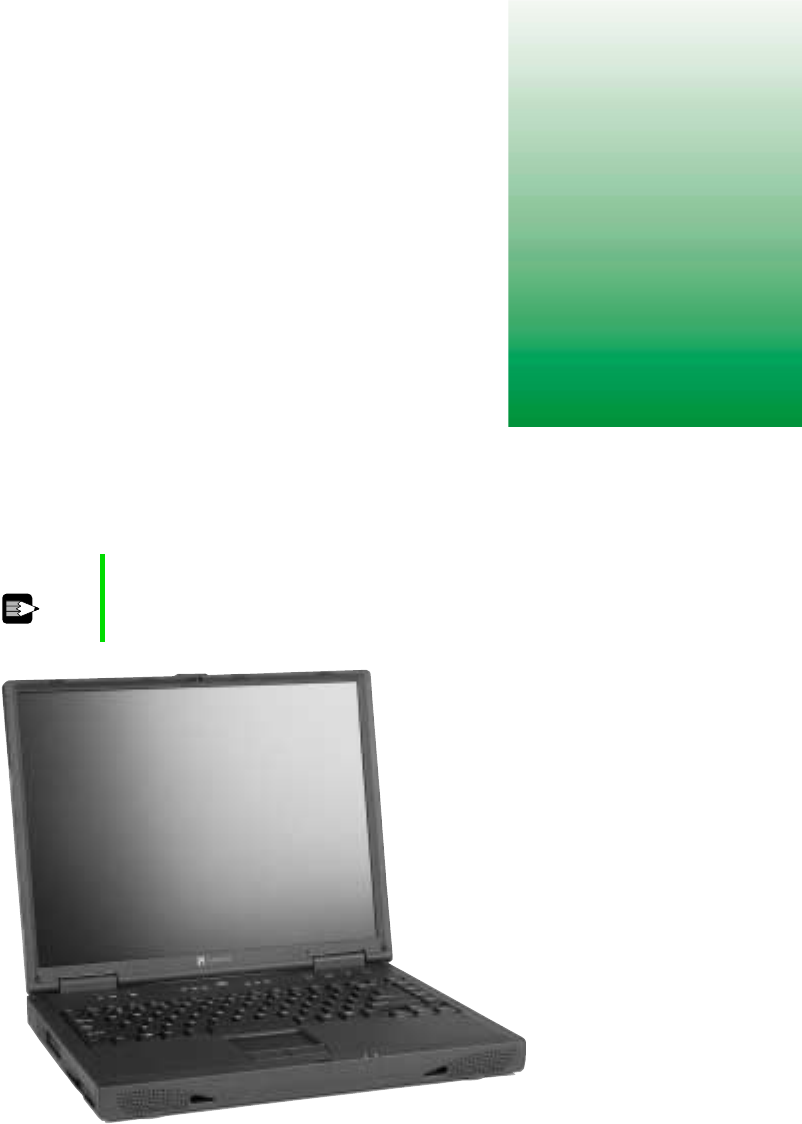
1
1
Checking Out
Your Gateway
Solo 9500
If you purchased the Gateway Solo 9550, go to “Checking Out Your Gateway
Solo 9550” on page 11.
Tips & Tricks To access the contents of this manual while you are
traveling, download an electronic copy from
www.gateway.com/support/manlib/.
Solo9550.book Page 1 Tuesday, June 19, 2001 3:18 PM
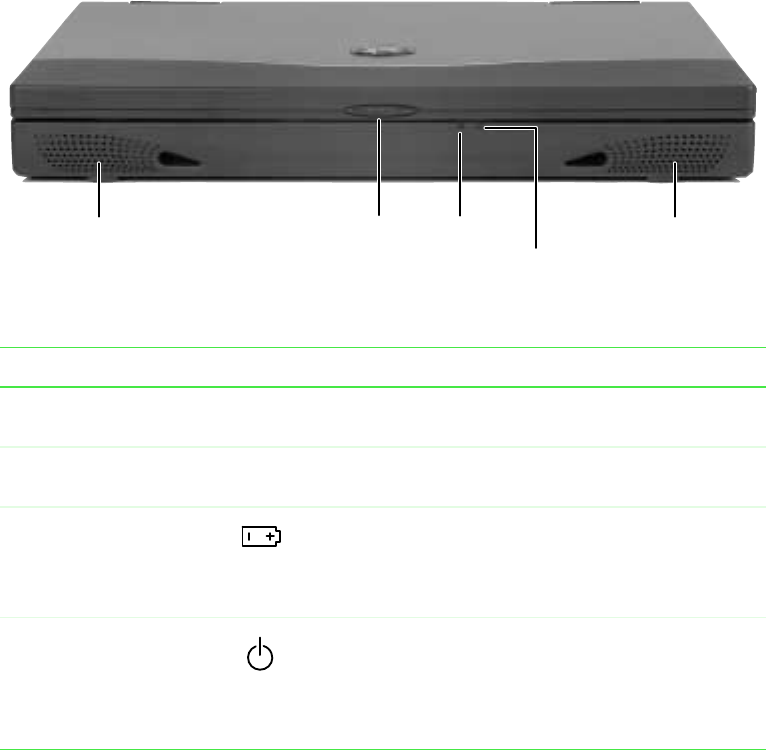
2 Checking Out Your Gateway Solo 9500
Front
Component Icon Description
Speakers Provide audio output when headphones or speakers are
not plugged in.
Release latch Open the notebook cover by sliding the release latch to
the right.
Battery charge indicator Lights up when the computer is plugged in.
■LED green –battery is fully charged.
■LED orange –battery is charging.
■LED off –notebook is running on battery power.
Power indicator Lights up when the notebook is turned on and shows
notebook power status:
■LED on –power is ON.
■LED blinking –power is in Standby or Suspend mode.
■LED off –power is off.
Speaker Release latch Battery
indicator
light
Speaker
Power
indicator
light
Solo9550.book Page 2 Tuesday, June 19, 2001 3:18 PM
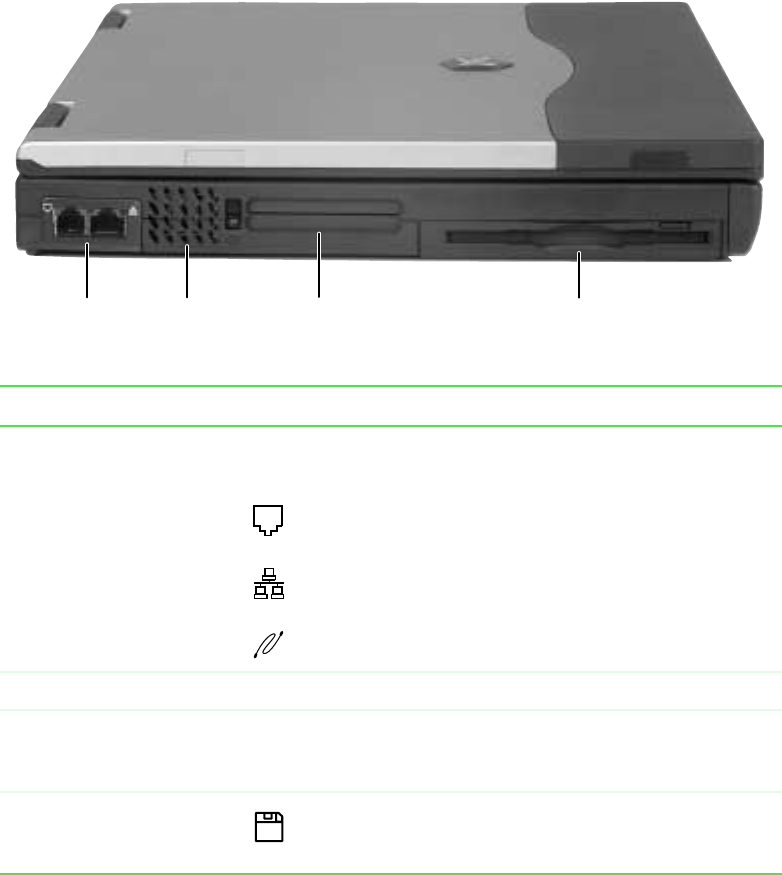
Left side 3
Left side
Component Icon Description
Port options Depending on the options you ordered with your
notebook, this area can contain:
■A modem jack
■An Ethernet jack
■An IEEE 1394 (Firewire) port
Ventilation fan Helps cool internal components. Do not block.
PC Card slots Insert one Type I, II, III or Zoom Video PC Card into this
slot. For more information, see “Adding PC Cards” on
page 166.
3.5” modular bay Install a standard 3.5-inch diskette drive or an LS-120
drive. For more information, see “Using drives” on
page 98 and “Changing 3.5” bay modules” on page 170.
Port
options Ventilation fan
(do not block) PC Card
slots 3.5” modular
bay
Solo9550.book Page 3 Tuesday, June 19, 2001 3:18 PM
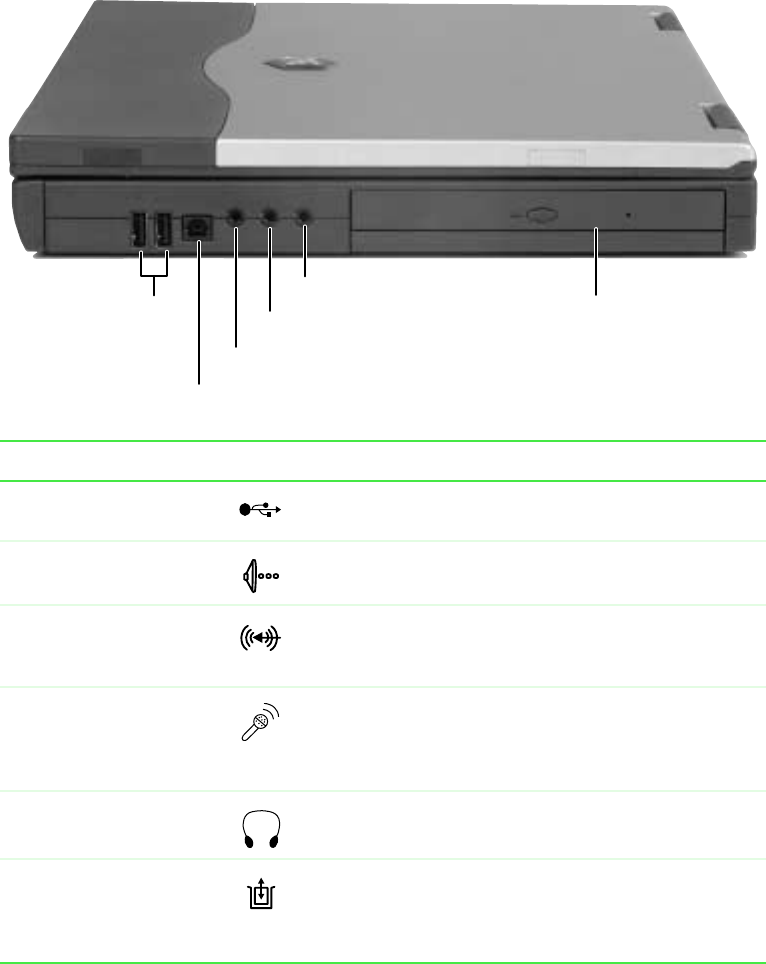
4 Checking Out Your Gateway Solo 9500
Right side
Component Icon Description
USB ports Plug USB (Universal Serial Bus) devices (such as a USB
printer, scanner, or camera) into these ports.
S/PDIF digital audio jack Plug an optical Toslink digital audio cable into this jack.
Line In jack Connect an external audio input source (such as a
stereo) to this jack so that you can record sound on your
computer or play sound through the notebook speakers.
Microphone jack Plug a microphone into this jack. The built-in microphone
is turned off when a microphone is plugged into this jack.
For the location of your built-in microphone, see “Using
the keyboard” on page 36.
Headphone jack Plug amplified speakers or headphones into this jack.
5.25” modular bay Install a CD or DVD drive, a second hard drive, or a
second battery into this bay. For more information, see
“Installing a second battery” on page 134 or “Changing
5.25” bay modules” on page 168.
USB
ports
S/PDIF digital audio jack
Line In jack
Microphone jack
Headphone jack
5.25” modular
bay
Solo9550.book Page 4 Tuesday, June 19, 2001 3:18 PM
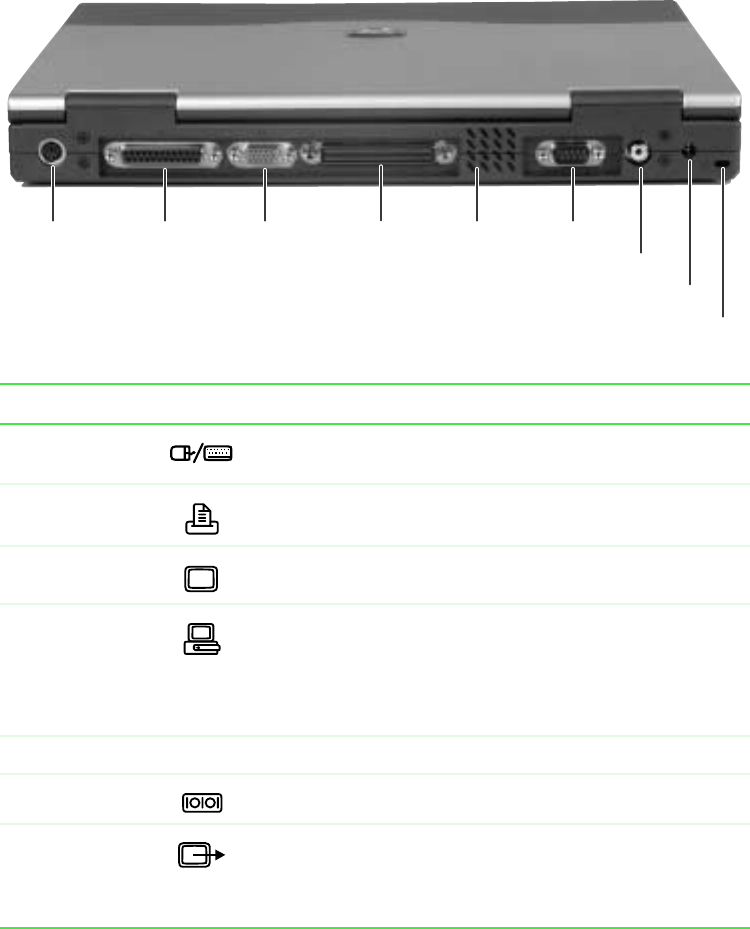
Back 5
Back
Component Icon Description
PS/2 port Plug a PS/2 device (such as a keyboard or mouse) into this
port.
Parallel port Plug a parallel device (such as a printer) into this port.
Monitor port Plug an analog VGA monitor into this port.
Docking port Connect the optional docking station or port replicator to this
port.
Warning! Power is passed through this port. This docking
connection is UL certified for use only with Solo 9500 docking
stations or port replicators.
Ventilation fan Helps cool internal components. Do not block.
Serial port Plug a serial device (such as a digital camera) into this port.
TV out jack Plug a TV into this jack so that you can view your notebook
display on a TV using NTSC/PAL composite video. For more
information, see “Viewing the display on a television” on
page 117.
Power connector
TV out jack
Kensington lock slot
Serial port
PS/2 port Parallel
port Monitor
port Docking
port Ventilation fan
(do not block)
Solo9550.book Page 5 Tuesday, June 19, 2001 3:18 PM

6 Checking Out Your Gateway Solo 9500
Power connector Plug the AC adapter cable into this connector.
Kensington
lock slot Secure your computer to an object by connecting a Kensington
cable lock to this slot.
Component Icon Description
Solo9550.book Page 6 Tuesday, June 19, 2001 3:18 PM
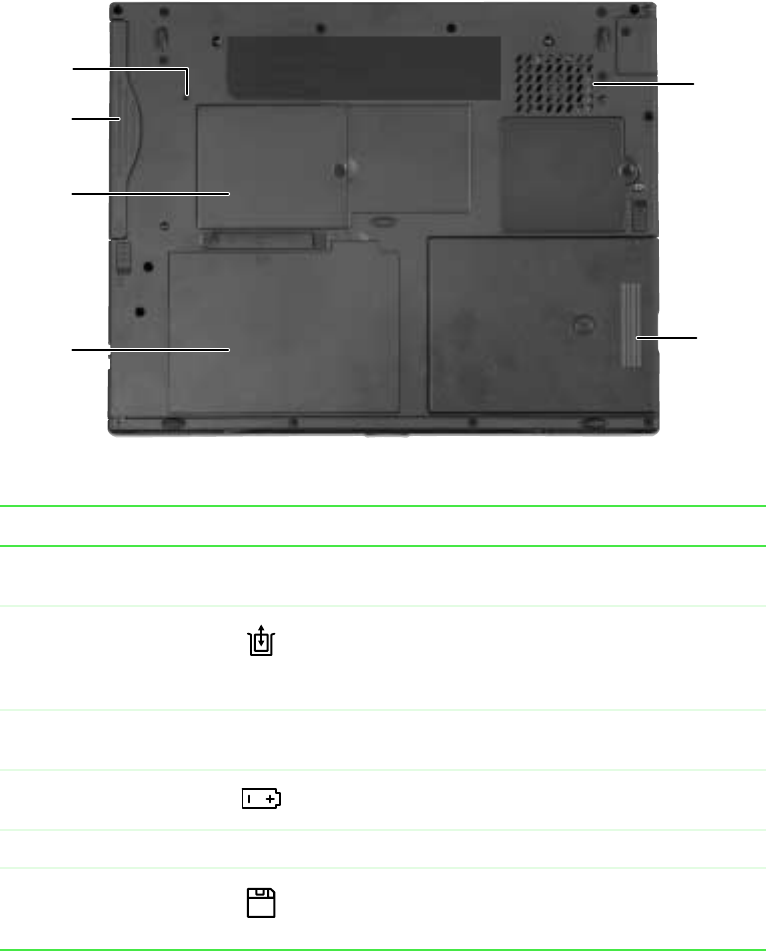
Bottom 7
Bottom
Component Icon Description
Reset hole Insert a straightened paper clip into this hole to manually
restart the system.
5.25” modular bay Install a CD or DVD drive, a second hard drive, or a
second battery into this bay. For more information, see
“Installing a second battery” on page 134 or “Changing
5.25” bay modules” on page 168.
Memory bay Install memory modules into this bay. For more
information, see “Installing memory” on page 172.
Battery bay Insert the battery into this bay. For more information, see
“Changing the main battery” on page 132.
Ventilation fan Helps cool internal components. Do not block.
3.5” modular bay Install a standard 3.5-inch diskette drive or an LS-120
drive. For more information, see “Using drives” on
page 98 and “Changing 3.5” bay modules” on page 170.
Memory bay
5.25” modular
bay
Battery bay
Ventilation
fan
Reset hole
3.5” modular
bay
Solo9550.book Page 7 Tuesday, June 19, 2001 3:18 PM
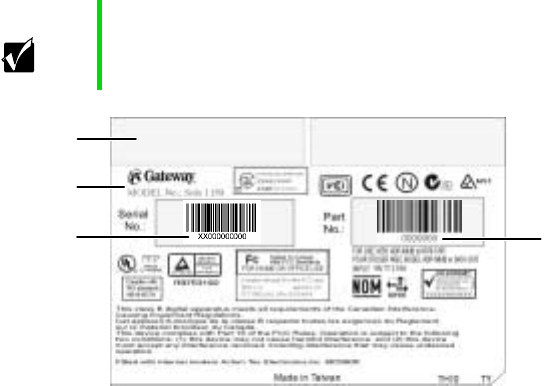
8 Checking Out Your Gateway Solo 9500
Identifying your model
The label on the bottom of your computer contains information that
identifies your notebook model. Gateway Technical Support will need this
information if you call for assistance.
Important The label shown below is for informational purposes only.
Label information varies by model.
00.0X/000XXX X 0.0/XX
Gateway part
number
Gateway model
number
Gateway serial
number
Revision code and display
type/ processor size
Solo9550.book Page 8 Tuesday, June 19, 2001 3:18 PM
Accessories 9
Accessories
Gateway offers accessories that can help you make the most of using your
notebook.
Batteries and automobile/airplane power adapters
If you run your notebook on battery power for extended periods, you may
want to buy an additional battery so that you can swap batteries when
necessary.
With an automobile/airplane power adapter, you can save battery power by
plugging your notebook into an automobile cigarette lighter or an airplane
in-flight power receptacle.
Carrying cases
Gateway has large-capacity carrying cases if you need additional space for
accessories or supplies.
Docking stations or port replicators
Although you can attach external devices directly to your notebook, a docking
station or port replicator lets you make all of those connections at once. When
you travel with your notebook, you merely disconnect from the docking
station or port replicator instead of unplugging all the external devices.
A docking station or port replicator also provides additional ports and other
expansion features not included with your notebook.
External devices
You can attach external devices such as a keyboard, mouse, printer, or monitor
to your notebook or docking station.
Memory
Large programs, such as multimedia games or graphics programs, use a lot of
memory. If your programs are running more slowly than you think they
should, try adding more memory.
Printers
You can attach many types of printers to your computer. The most common
types are inkjet and laser printers, which print in color or black and white.
Solo9550.book Page 9 Tuesday, June 19, 2001 3:18 PM
10 Checking Out Your Gateway Solo 9500
Inkjet printers and cartridges are relatively inexpensive, but usually they are
slower than laser printers. Using an inkjet color printer, you can print pictures,
banners, and greeting cards, as well as documents.
Laser printers and cartridges are more expensive, but usually they print much
faster than inkjet printers. Laser printers are better than inkjet printers when
you are printing large documents.
Solo9550.book Page 10 Tuesday, June 19, 2001 3:18 PM
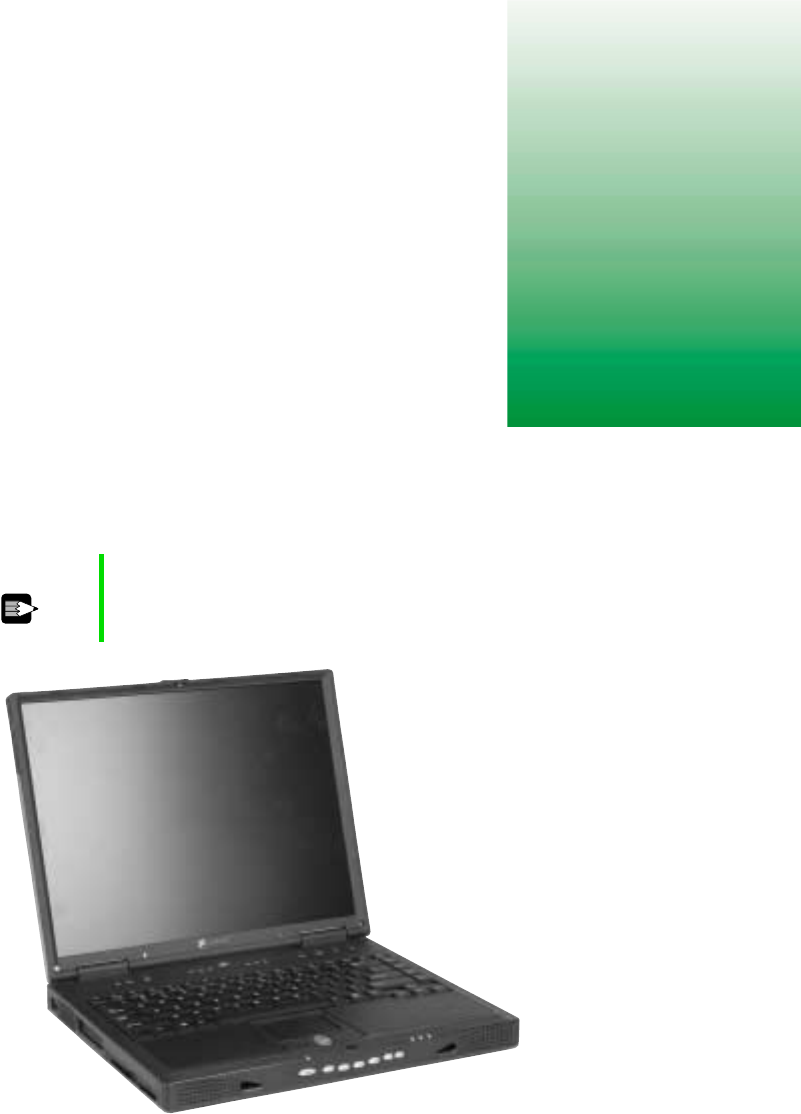
11
2
www.gateway.com
Checking Out
Your Gateway
Solo 9550
If you purchased the Gateway Solo 9500, go to “Checking Out Your Gateway
Solo 9500” on page 1.
Tips & Tricks To access the contents of this manual while you are
traveling, download an electronic copy from
www.gateway.com/support/manlib/.
Solo9550.book Page 11 Tuesday, June 19, 2001 3:18 PM
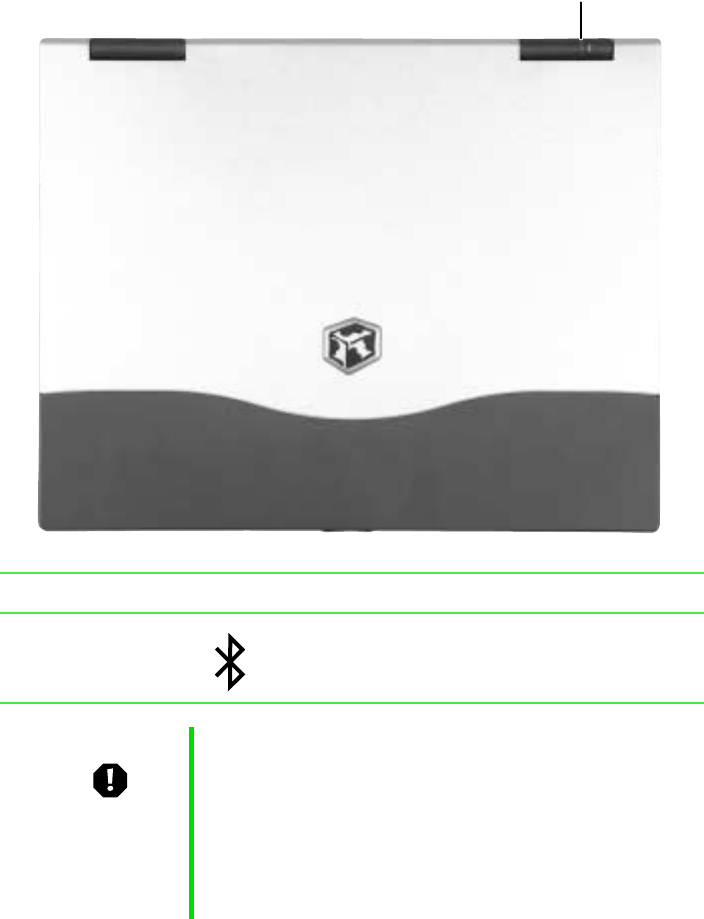
12
Chapter 2: Checking Out Your Gateway Solo 9550
www.gateway.com
Top
Component Icon Description
Bluetooth indicator
(optional) Lights up when Bluetooth is turned on.
Warning Radio frequency wireless communication can interfere
with equipment on commercial aircraft. Current aviation
regulations require wireless devices to be turned off while
traveling in an airplane. Bluetooth and IEEE 802.11b (also
known as wireless Ethernet or WiFi) communication
devices are examples of devices that provide wireless
communication. For instructions to turn Bluetooth on and
off, see “Multi-function buttons” on page 40.
Bluetooth Indicator
Solo9550.book Page 12 Tuesday, June 19, 2001 3:18 PM
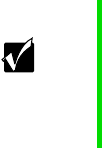
13
Top
www.gateway.com
Important If your system came equipped with an internal radio
frequency wireless device, see “Safety, Regulatory, and
Legal Information” on page 281 for general wireless
regulatory and safety guidelines. To find out if your system
has an internal wireless device, check the label (see
“Identifying your model” on page 23).
Solo9550.book Page 13 Tuesday, June 19, 2001 3:18 PM
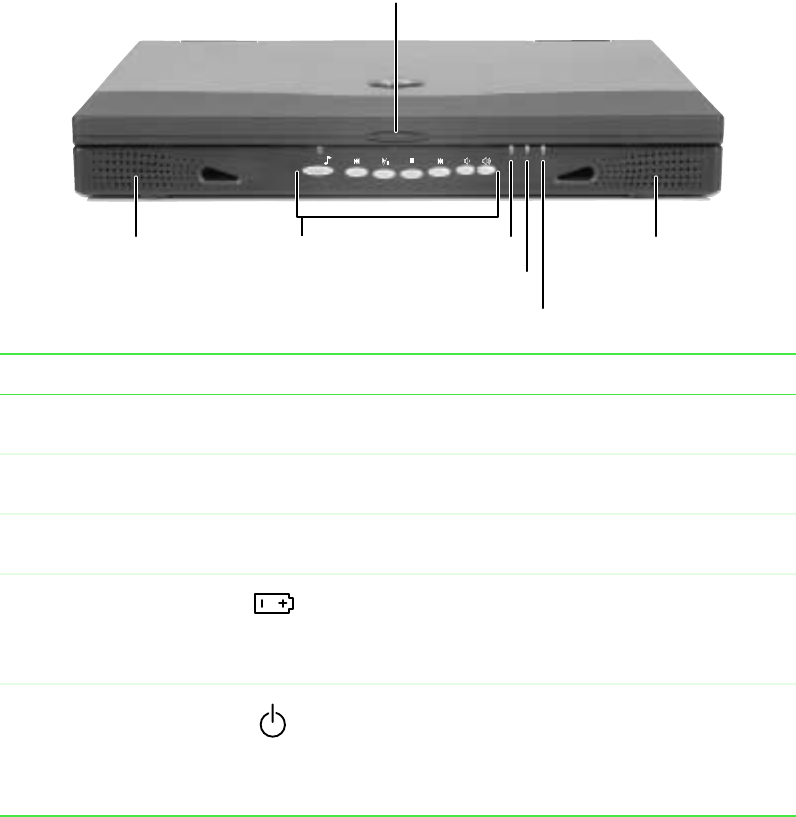
14
Chapter 2: Checking Out Your Gateway Solo 9550
www.gateway.com
Front
Component Icon Description
Cover release latch Open notebook cover by sliding the release latch to the
right.
Speakers Provide audio output when headphones or speakers are
not plugged in.
Audio DJ controls Control the built-in CD player. For more information, see
“Using Audio DJ on the Solo 9550” on page 100.
Battery charge indicator Lights up when the computer is plugged in.
■LED green - battery is fully charged.
■LED orange - battery is charging.
■LED off - notebook is running on battery power.
Power indicator Lights up when the notebook is turned on and shows
notebook power status:
■LED on - power is ON.
■LED blinking - power is in Standby or Suspend mode
■LED off - power is off.
Battery charge
indicator
Cover release latch
Speaker Speaker
Audio DJ
controls Power indicator
Hot-swap indicator
Solo9550.book Page 14 Tuesday, June 19, 2001 3:18 PM

15
Front
www.gateway.com
Hot-swap indicator Indicates when it is safe to remove the 5.25” bay module.
■LED green - it is safe to remove the 5.25” bay module.
■LED orange - it is not safe to remove the 5.25” bay
module.
For more information, see “Changing 5.25” bay modules”
on page 168.
Component Icon Description
Solo9550.book Page 15 Tuesday, June 19, 2001 3:18 PM
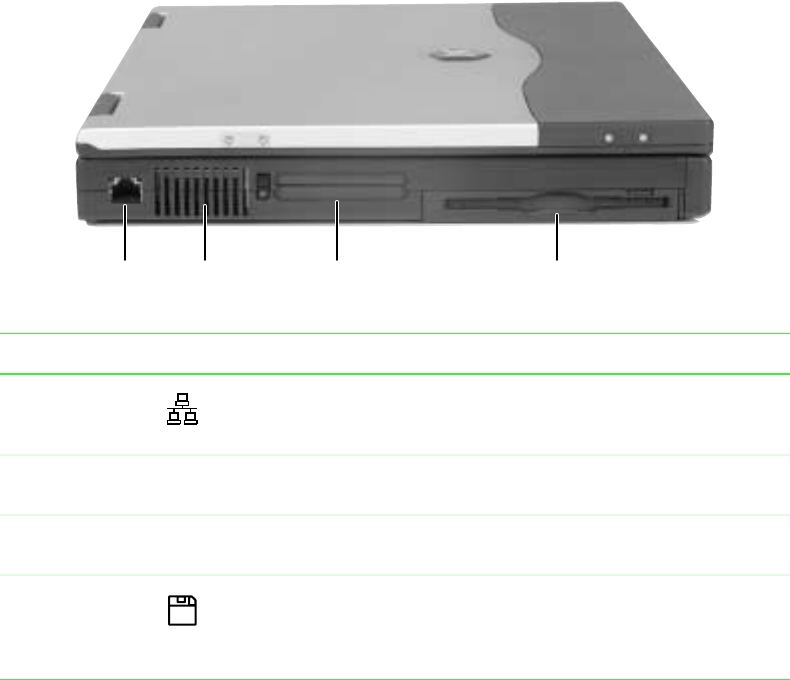
16
Chapter 2: Checking Out Your Gateway Solo 9550
www.gateway.com
Left
Component Icon Description
Ethernet jack Plug a 10/100 Ethernet network cable into this jack. For more
information, see “Connecting to an Ethernet network” on page 46 and
“Networking Your Computer” on page 199.
Fan Helps cool internal components. Do not block or insert objects into
these slots.
PC Card slot Insert one Type I, II, or III PC Card into this slot. For more information,
see “Adding PC Cards” on page 166.
3.5” modular
bay Install a standard 3.5-inch diskette drive, an additional hard drive, or
a second battery into this bay. For more information, see “Installing
a second battery” on page 134 and “Changing 3.5” bay modules” on
page 170.
Ethernet
jack Fan PC Card slot 3.5” modular bay
Solo9550.book Page 16 Tuesday, June 19, 2001 3:18 PM
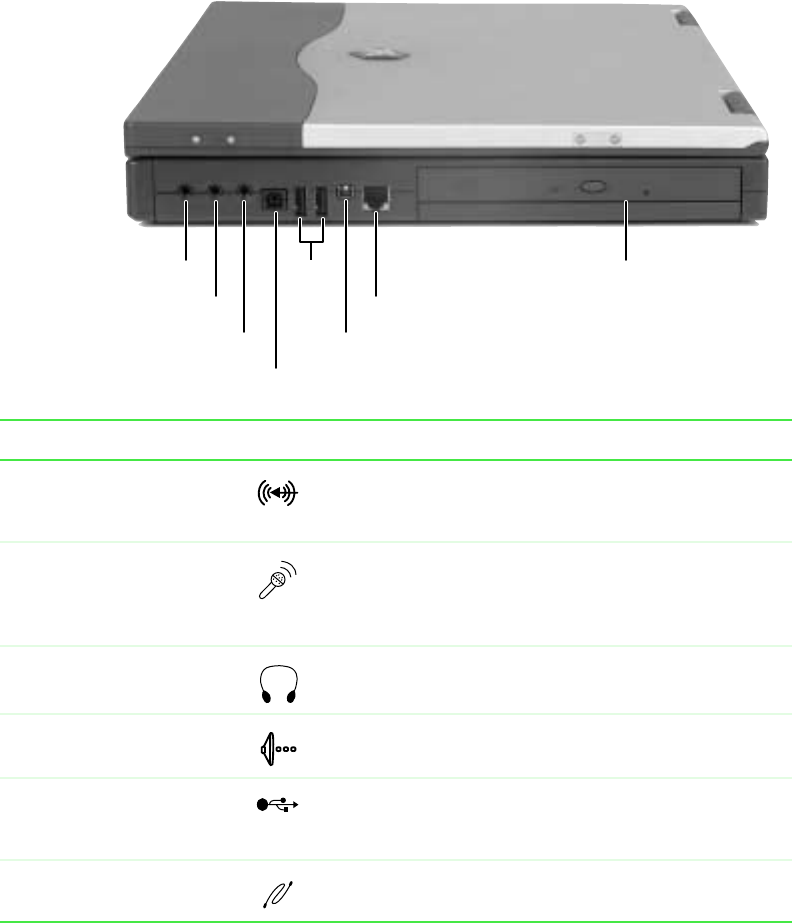
17
Right
www.gateway.com
Right
Component Icon Description
Line in jack Connect an external audio input source (such as a
stereo) to this jack so that you can record sound on your
computer or play sound through the notebook speakers.
Microphone jack Plug a microphone into this jack. The built-in
microphone is turned off when a microphone is plugged
into this jack. For the location of your built-in
microphone, see “Using the keyboard” on page 36.
Headphone jack Plug amplified speakers or headphones into this jack.
S/PDIF digital audio jack Plug an optical Toslink digital audio cable into this jack.
USB ports Plug USB (Universal Serial Bus) devices (such as a
USB Iomega™ Zip™ drive, printer, scanner, or camera)
into these ports.
IEEE 1394 port Plug an IEEE 1394 (Firewire) cable into this jack.
Line in jack
Microphone jack
Headphone jack
USB
ports
S/PDIF digital audio jack IEEE 1394 port
5.25” modular bay
Modem jack
Solo9550.book Page 17 Tuesday, June 19, 2001 3:18 PM

18
Chapter 2: Checking Out Your Gateway Solo 9550
www.gateway.com
Modem jack Plug a telephone cord into this jack.
5.25” modular bay Install a CD, DVD, or an additional hard drive into this
bay. For more information, see “Changing 5.25” bay
modules” on page 168.
Component Icon Description
Solo9550.book Page 18 Tuesday, June 19, 2001 3:18 PM
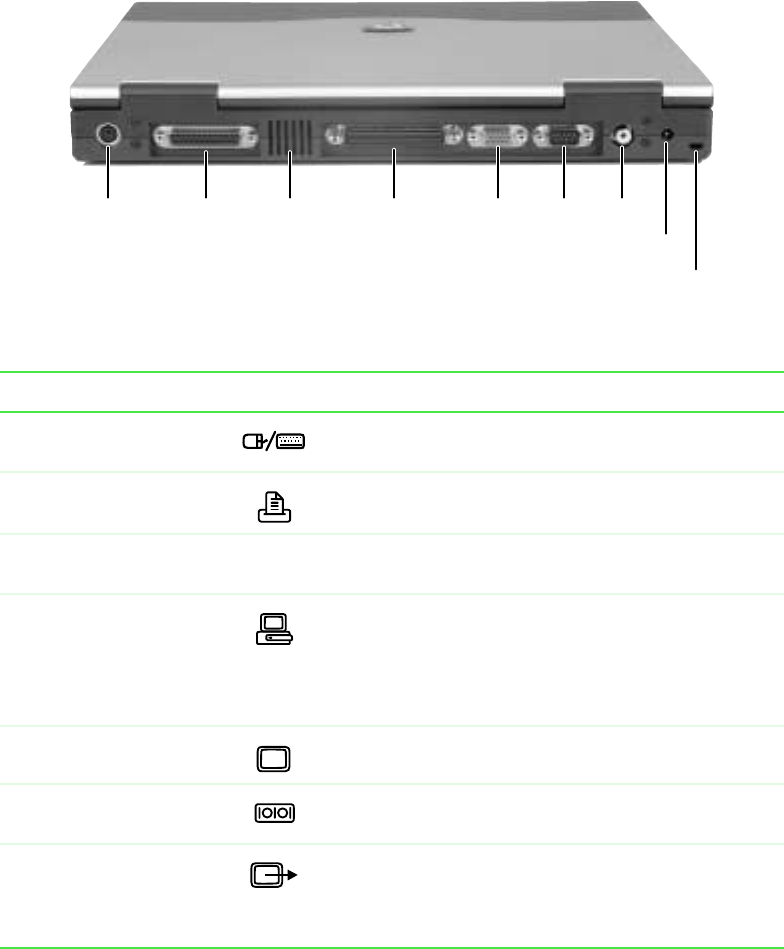
19
Back
www.gateway.com
Back
Component Icon Description
PS/2 port Plug a PS/2 device (such as a keyboard or mouse) into
this port.
Parallel port Plug a parallel device (such as a printer) into this port.
Fan Helps cool internal components. Do not block or insert
objects into these slots.
Docking port Connect the docking station or port replicator to this
port.
Warning! Power is passed through this port. This
docking connection is UL certified for use only with Solo
9550 docking stations or port replicators.
Monitor port Plug an analog VGA monitor into this port.
Serial port Plug a serial device (such as a digital camera) into this
port.
TV out jack Plug a TV into this jack so that you can view your
computer screen on a TV using NTSC/PAL composite
video. For more information, see “Viewing the display on
a television” on page 117.
PS/2
port
Parallel
port Fan Docking
port Monitor
port Serial
port
TV out
jack
Power connector
Kensington lock
slot
Solo9550.book Page 19 Tuesday, June 19, 2001 3:18 PM

20
Chapter 2: Checking Out Your Gateway Solo 9550
www.gateway.com
Power connector Plug the AC adapter cable into this connector.
Kensington™ lock slot Secure your computer to an object by connecting a
Kensington cable lock to this slot.
Component Icon Description
Solo9550.book Page 20 Tuesday, June 19, 2001 3:18 PM
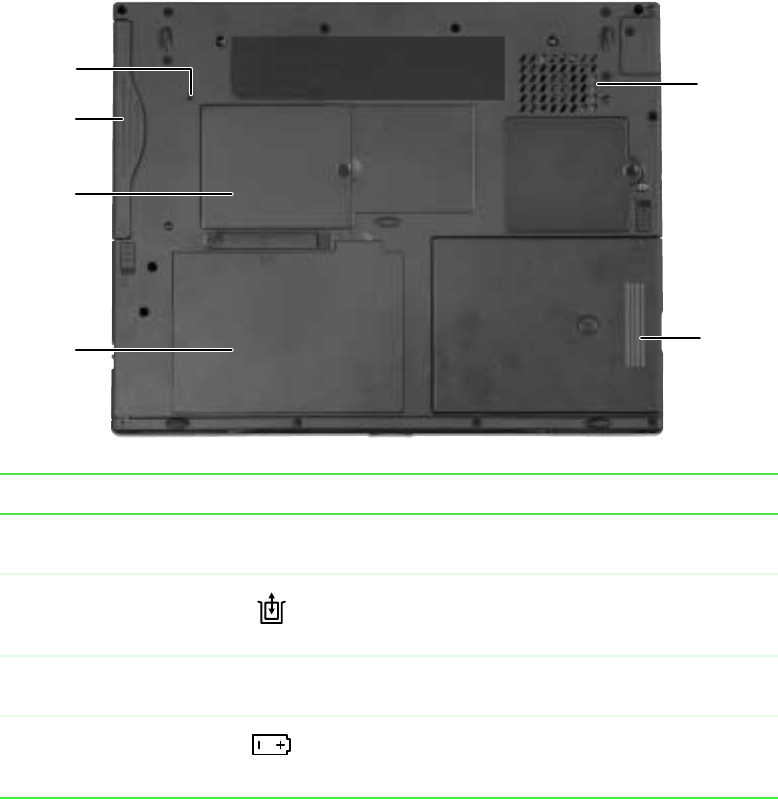
21
Bottom
www.gateway.com
Bottom
Component Icon Description
Reset hole Insert a straightened paper clip into this hole to manually
restart the system.
5.25” modular bay Install a CD, DVD, or an additional hard drive into this
bay. For more information, see “Changing 5.25” bay
modules” on page 168.
Memory bay Install a memory module in this bay. For more
information, see “Installing memory” on page 172.
Battery bay Insert the main battery into this bay. For more
information, see “Changing the main battery” on
page 132.
Reset
hole
5.25”
modular
bay
Memory
bay
Battery
bay
Fan
3.5”
modular
bay
Solo9550.book Page 21 Tuesday, June 19, 2001 3:18 PM

22
Chapter 2: Checking Out Your Gateway Solo 9550
www.gateway.com
Fan Helps cool internal components. Do not block or insert
objects into these slots.
3.5” modular bay Install a standard 3.5-inch diskette drive, an additional
hard drive, or a second battery into this bay. For more
information, see “Installing a second battery” on
page 134 and “Changing 3.5” bay modules” on
page 170.
Component Icon Description
Solo9550.book Page 22 Tuesday, June 19, 2001 3:18 PM
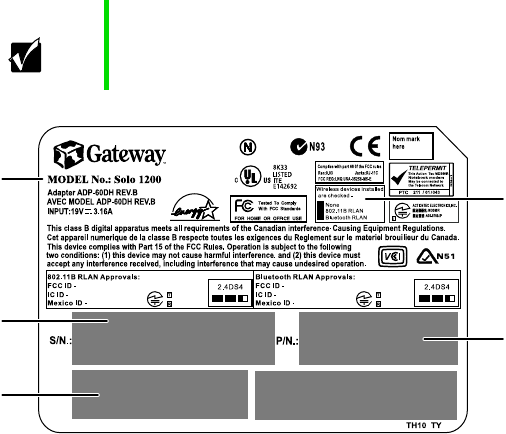
23
Identifying your model
www.gateway.com
Identifying your model
The label on the bottom of your computer contains information that
identifies your notebook model. Gateway Technical Support will need this
information if you call for assistance.
Important The label shown below is for informational purposes only.
Label information varies by model.
Gateway part
number
Gateway
model
number
Gateway
serial
number
Revision
code and
display
type/
processor
size
Internal
wireless
devices
Solo9550.book Page 23 Tuesday, June 19, 2001 3:18 PM
24
Chapter 2: Checking Out Your Gateway Solo 9550
www.gateway.com
Accessories
Gateway offers accessories that can help you make the most of using your
notebook.
Batteries and automobile/airplane power adapters
If you run your notebook on battery power for extended periods, you may
want to buy an additional battery so that you can swap batteries when
necessary.
With an automobile/airplane power adapter, you can save battery power by
plugging your notebook into an automobile cigarette lighter or an airplane
in-flight power receptacle.
Carrying cases
Gateway has large-capacity carrying cases if you need additional space for
accessories or supplies.
Docking stations or port replicators
Although you can attach external devices directly to your notebook, a docking
station or port replicator lets you make all of those connections at once. When
you travel with your notebook, you merely disconnect from the docking
station or port replicator instead of unplugging all the external devices.
A docking station or port replicator also provides additional ports and other
expansion features not included with your notebook.
External devices
You can attach external devices such as a keyboard, mouse, printer, or monitor
to your notebook or docking station.
Memory
Large programs, such as multimedia games or graphics programs, use a lot of
memory. If your programs are running more slowly than you think they
should, try adding more memory.
Printers
You can attach many types of printers to your computer. The most common
types are inkjet and laser printers, which print in color or black and white.
Solo9550.book Page 24 Tuesday, June 19, 2001 3:18 PM
25
Accessories
www.gateway.com
Inkjet printers and cartridges are relatively inexpensive, but usually they are
slower than laser printers. Using an inkjet color printer, you can print pictures,
banners, and greeting cards, as well as documents.
Laser printers and cartridges are more expensive, but usually they print much
faster than inkjet printers. Laser printers are better than inkjet printers when
you are printing large documents.
Solo9550.book Page 25 Tuesday, June 19, 2001 3:18 PM
26
Chapter 2: Checking Out Your Gateway Solo 9550
www.gateway.com
Solo9550.book Page 26 Tuesday, June 19, 2001 3:18 PM

27
3
www.gateway.com
Getting Started
This chapter provides basic information about your Gateway notebook. Read
this chapter to find out:
■How to connect the AC adapter
■How to start and turn off your notebook
■How to use the keyboard
■How to use the EZ Pad™ touchpad
■How to connect the modem
■How to connect to an Ethernet network
■How to install peripheral devices
Solo9550.book Page 27 Tuesday, June 19, 2001 3:18 PM
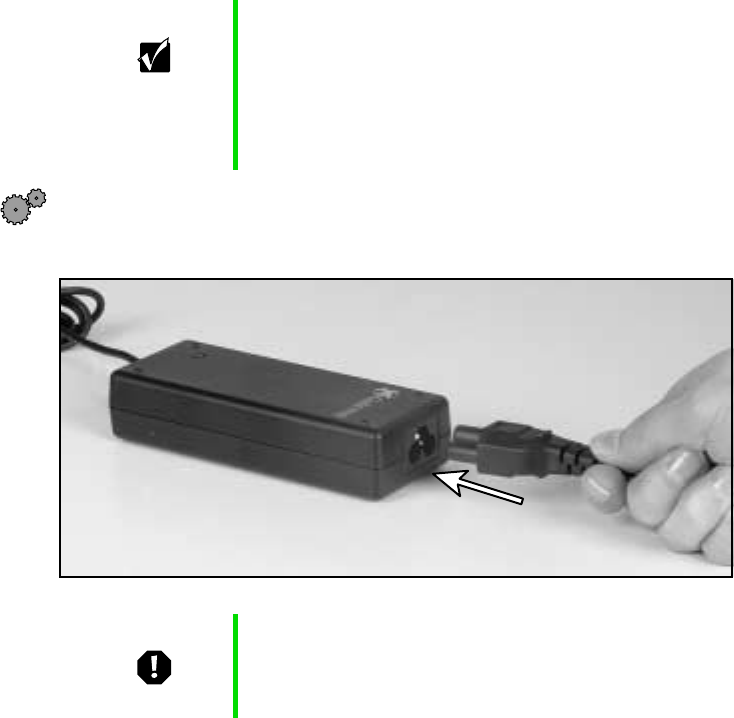
28
Chapter 3: Getting Started
www.gateway.com
Connecting the AC adapter
You can run your notebook using an AC adapter or the notebook battery. The
battery was shipped to you partially charged. You should use the AC adapter
right away to fully charge the battery. Allow 24 hours for the battery to fully
charge.
To connect the AC adapter:
1Connect the power cord to the AC adapter.
Important If the battery is not fully charged before you use your
notebook on battery power for the first time, the battery life
may be much shorter than you expect. If the battery life
seems short even after being charged for 24 hours, the
battery may need to be recalibrated. For information on
recalibrating the battery, see “Recalibrating the battery” on
page 229.
Warning Replace the power cord if it becomes damaged. The
replacement cord must be of the same type and voltage
rating as the original cord or the notebook may be
damaged.
Solo9550.book Page 28 Tuesday, June 19, 2001 3:18 PM
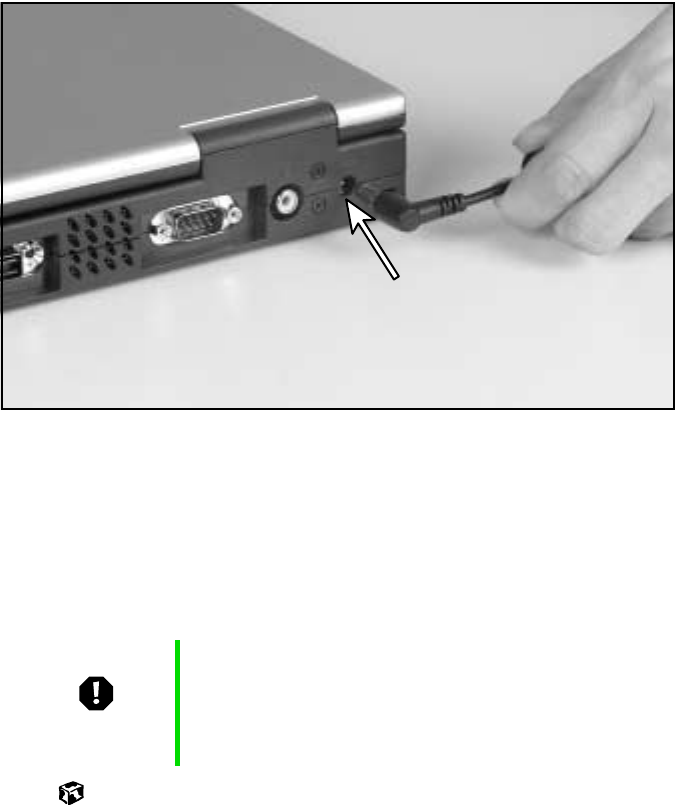
29
Connecting the AC adapter
www.gateway.com
2Connect the AC adapter to your notebook’s power connector.
3Plug the power cord in to a wall power outlet.
The battery charging indicator light turns on. If the battery charging
indicator light does not turn on, disconnect the adapter from your
notebook and repeat Step 2.
4When you finish using your notebook, turn the notebook off and leave
the notebook connected to AC power for at least 24 hours.
Warning Do not attempt to disassemble the AC adapter. The
AC adapter has no user-replaceable or user-serviceable
parts inside. The AC adapter has dangerous voltages that
can cause serious injury or death. Contact Gateway about
returning defective AC adapters.
Solo9550.book Page 29 Tuesday, June 19, 2001 3:18 PM
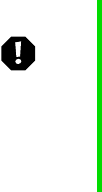
30
Chapter 3: Getting Started
www.gateway.com
Protecting from power source problems
During a power surge, the voltage level of electricity coming into your
computer can increase to far above normal levels and cause data loss or system
damage. Protect your computer and peripherals by connecting them to a surge
protector, which will absorb voltage surges and prevent them from reaching
your computer.
Warning High voltages can enter your computer through both the
power cord and the modem connection. Protect your
computer by using a surge protector. If you have a
telephone modem, use a surge protector that has a
modem jack. If you have a cable modem, use a surge
protector that has an antenna/cable TV jack. During an
electrical storm, unplug both the surge protector and the
modem.
Solo9550.book Page 30 Tuesday, June 19, 2001 3:18 PM
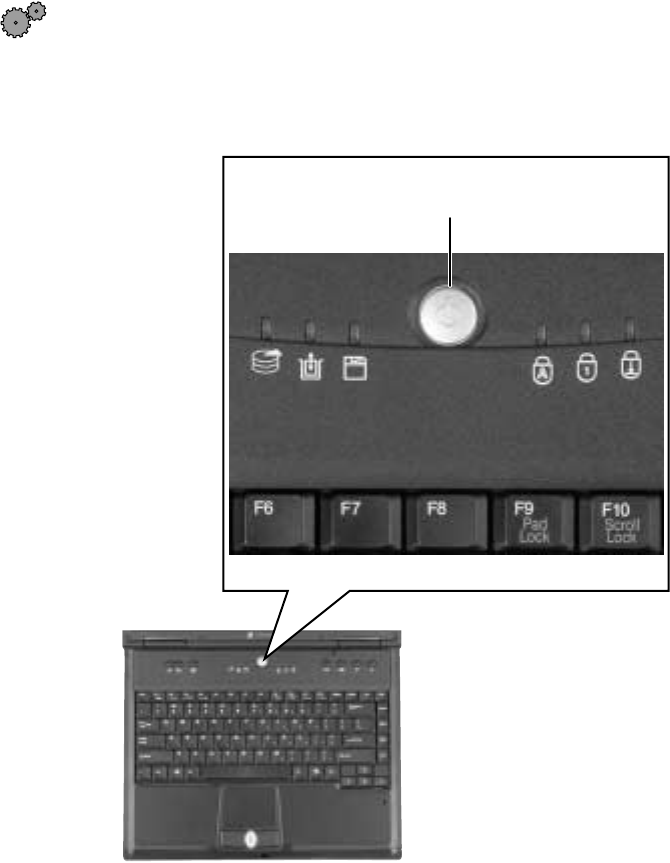
31
Starting your notebook
www.gateway.com
Starting your notebook
To start the notebook:
1Open your notebook by sliding the latch on the front of your notebook
to the right and lifting the LCD panel.
2Press the power button located above the keyboard.
Power button
Solo9550.book Page 31 Tuesday, June 19, 2001 3:18 PM

32
Chapter 3: Getting Started
www.gateway.com
The power button is preset to On/Off mode. However, you can also set
it to function in Standby/Resume mode. For instructions on changing
the power button mode, see “Changing automatic power settings in
Windows Me, Windows 98, or Windows 2000” on page 138.
3If you are starting your computer for the first time, follow the on-screen
instructions to set up your computer.
Waking up your notebook
When you have not used your notebook for several minutes, it will go into
a power-saving mode called Standby. While in Standby, the power indicator
light blinks.
If your notebook has gone into Standby mode, “wake” it up by pressing the
power button. For more information on changing power-saving settings, see
“Changing automatic power settings in Windows Me, Windows 98, or
Windows 2000” on page 138.
Solo9550.book Page 32 Tuesday, June 19, 2001 3:18 PM
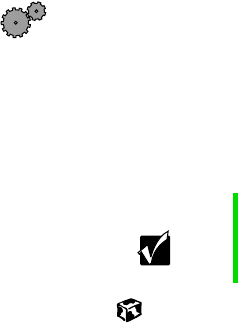
33
Turning off your notebook
www.gateway.com
Turning off your notebook
To turn off your notebook:
1Click Start, then select Shut Down. The Shut Down Windows dialog box
opens.
2Select Shut down.
3Click OK. Windows shuts down and turns off your notebook.
Important If for some reason you cannot use the Shut down option
in Windows to turn off your notebook, press and hold the
power button for about five seconds.
Solo9550.book Page 33 Tuesday, June 19, 2001 3:18 PM
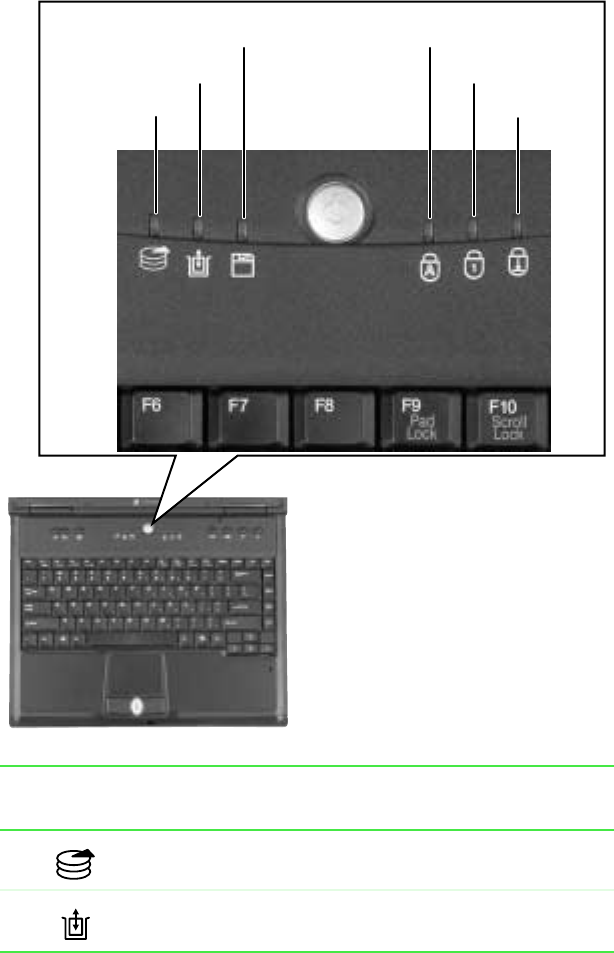
34
Chapter 3: Getting Started
www.gateway.com
Status indicators
This light turns
on... When...
The notebook is accessing a hard drive.
The notebook is accessing the 5.25” modular drive.
Hard drive
5.25” modular drive
Diskette drive
Scroll lock
Pad lock
Caps lock
Solo9550.book Page 34 Tuesday, June 19, 2001 3:18 PM
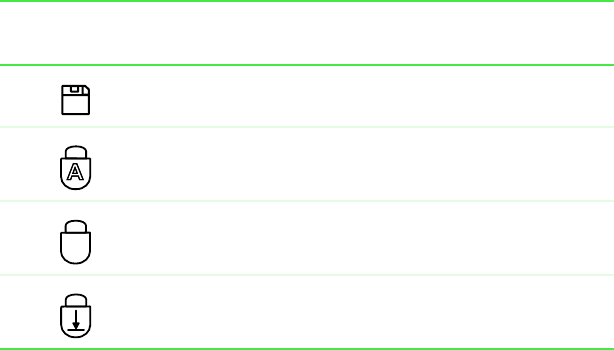
35
Status indicators
www.gateway.com
The notebook is accessing the diskette drive.
Caps Lock is turned on.
Pad Lock is turned on.
Scroll Lock is turned on.
This light turns
on... When...
1
Solo9550.book Page 35 Tuesday, June 19, 2001 3:18 PM
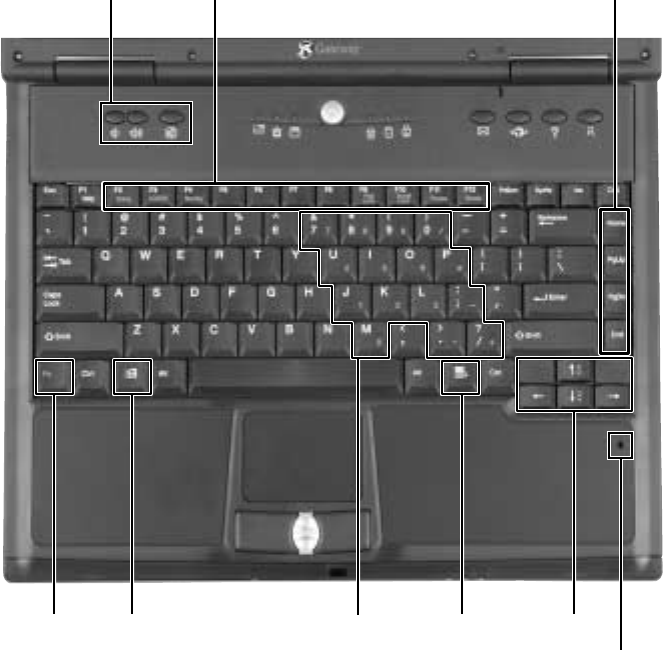
36
Chapter 3: Getting Started
www.gateway.com
Using the keyboard
Your notebook features a full-size keyboard that has the full functionality of
a desktop computer keyboard. Many of the keys have been assigned alternate
functions, including shortcut keys for Windows, function keys for specific
system operations, and the Pad Lock keys for the numeric keypad.
You can attach an external keyboard to the notebook using a USB or PS/2 port.
You do not need to shut down the notebook to connect a keyboard.
FN key Windows
key Numeric
keypad Application
key
Arrow keys
Navigation
keys
Function/
system keys
Volume control
buttons
Built-in
microphone
Solo9550.book Page 36 Tuesday, June 19, 2001 3:18 PM

37
Using the keyboard
www.gateway.com
Keys
Component Icon Description
Volume control
buttons Press the volume buttons to change the volume, or
press the mute button to turn off all sound.
Function keys Press these keys labeled F1 to F12 to perform actions
in programs. For example, pressing F1 may open help.
Each program uses different function keys for different
purposes. Refer to the program documentation to find
out more about the function key actions.
System keys Press these green or blue-colored keys in combination
with the FNkey to perform specific actions.
Navigation keys Press these keys to move the cursor to the beginning
of a line, to the end of a line, up the page, down the
page, to the beginning of a document, or to the end
of a document.
FN key Press the FNkey in combination with a green or
blue-colored system key (such as STANDBY, PAUSE, or
BLUETOOTH) to perform a specific action.
Windows key Press to open the Windows Start menu. This key can
also be used in combination with other keys to open
utilities like F(Search utility), R(Run utility), and
E(Explorer utility).
Numeric keypad Use these keys to type numbers when the numeric
keypad is turned on. Press FN+PAD LOCK to turn on
the numeric keypad.
Application key Press for quick access to shortcut menus and help
assistants in Windows.
Arrow keys Press these keys to move the cursor up, down, right,
or left.
Solo9550.book Page 37 Tuesday, June 19, 2001 3:18 PM
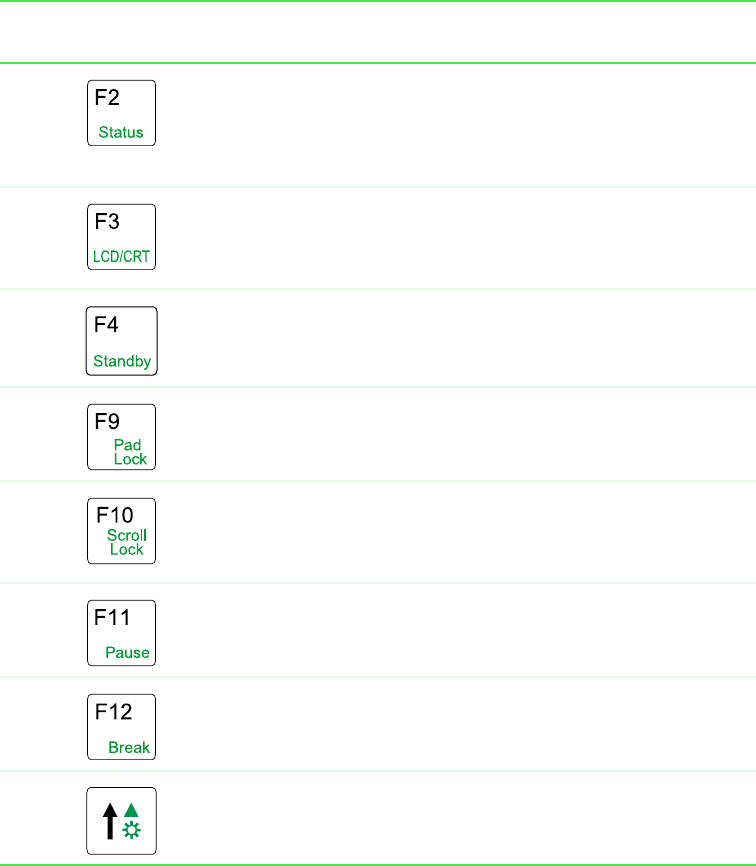
38
Chapter 3: Getting Started
www.gateway.com
System key combinations
When you press an FNkey and a system key at the same time, the notebook
performs the action identified by the green or blue text on the key.
Press and hold FN while
pressing this system key... To...
Display the power status box in the upper left corner of your
screen. The box shows the battery charge level, the BIOS
version, and whether the AC adapter is being used. Press the
key combination again to close this box. (Available on the Solo
9500 only.)
Toggle the notebook screen between the LCD, an external
monitor, or both displays at the same time. A monitor must be
plugged into the monitor port on the notebook or docking
station.
Enter Standby mode. Press the power button to leave Standby
mode.
Turn on Pad Lock so you can use the numeric keypad. Press
this key combination again to turn off Pad Lock. The Pad Lock
status indicator appears while this function is turned on.
Pause the text scrolling in a DOS screen. The Scroll Lock
status indicator appears when this function is turned on. Press
the key combination again to continue scrolling. (This function
is only available in some programs.)
Pause execution of a DOS program. (This function is only
available in some programs.)
Stop the currently running DOS program. (This function is only
available in some programs.)
Increase the brightness of the display.
Solo9550.book Page 38 Tuesday, June 19, 2001 3:18 PM

39
Using the keyboard
www.gateway.com
Decrease the brightness of the display.
Turn Bluetooth on and off. (This function is only available on
notebooks equipped with Bluetooth.)
Press and hold FN while
pressing this system key... To...
Solo9550.book Page 39 Tuesday, June 19, 2001 3:18 PM
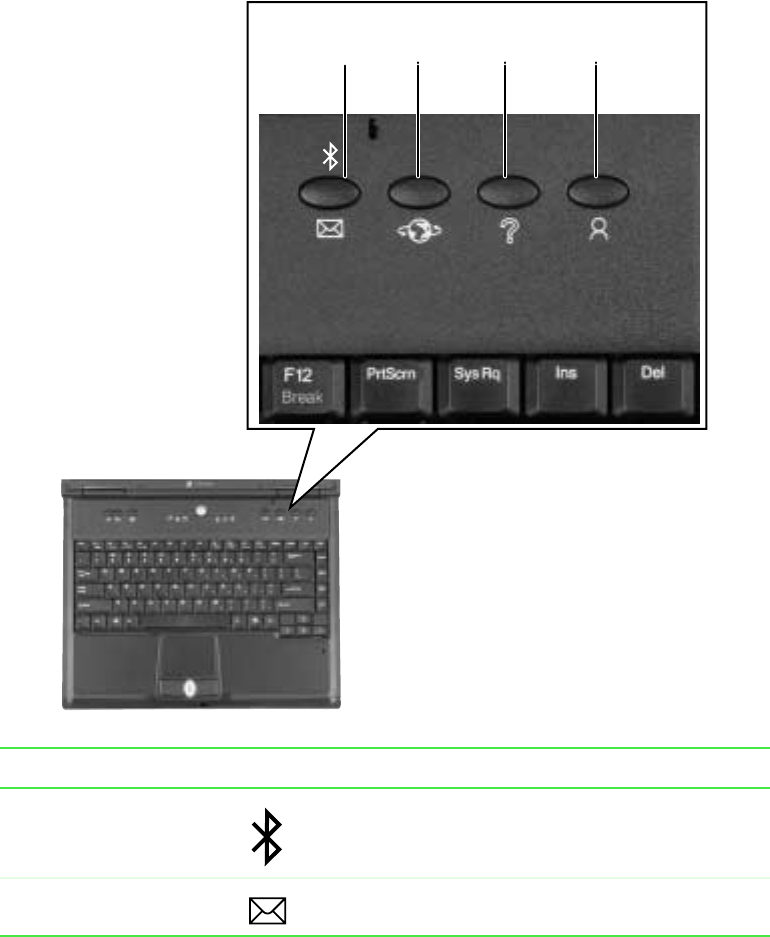
40
Chapter 3: Getting Started
www.gateway.com
Multi-function buttons
Button Icon Press to...
Bluetooth Turn Bluetooth on and off. This button must be pressed
at the same time the FN button is pressed. (This function
is only available on notebooks equipped with Bluetooth.)
E-mail Open your e-mail program.
Bluetooth/
E-mail Internet Help User-defined
shortcut
Solo9550.book Page 40 Tuesday, June 19, 2001 3:18 PM

41
Using the keyboard
www.gateway.com
Internet Open your Web browser.
Help Open online help.
User-defined shortcut Open the program you assign to this key.
Button Icon Press to...
Solo9550.book Page 41 Tuesday, June 19, 2001 3:18 PM
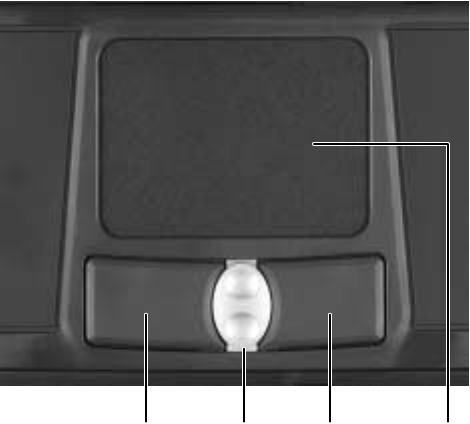
42
Chapter 3: Getting Started
www.gateway.com
Using the EZ Pad touchpad
The EZ Pad™ consists of a touchpad, two buttons, and a rocker switch. (The
rocker switch is available on the Solo 9550 only.)
When you move your finger on the touchpad, the pointer (arrow) on the screen
moves in the same direction.
You can use the EZ-Pad left and right buttons below the touchpad to select
objects. You can assign a function to the rocker switch between the touchpad
buttons on the Solo 9550. This function can be to scroll up or down, maximize
or minimize the active window, or open and close the Start menu. For more
information about programming the rocker switch, see “Changing the
touchpad settings” on page 161.
Left
touchpad
button
Right
touchpad
button
Rocker
switch
Touchpad
Solo9550.book Page 42 Tuesday, June 19, 2001 3:18 PM
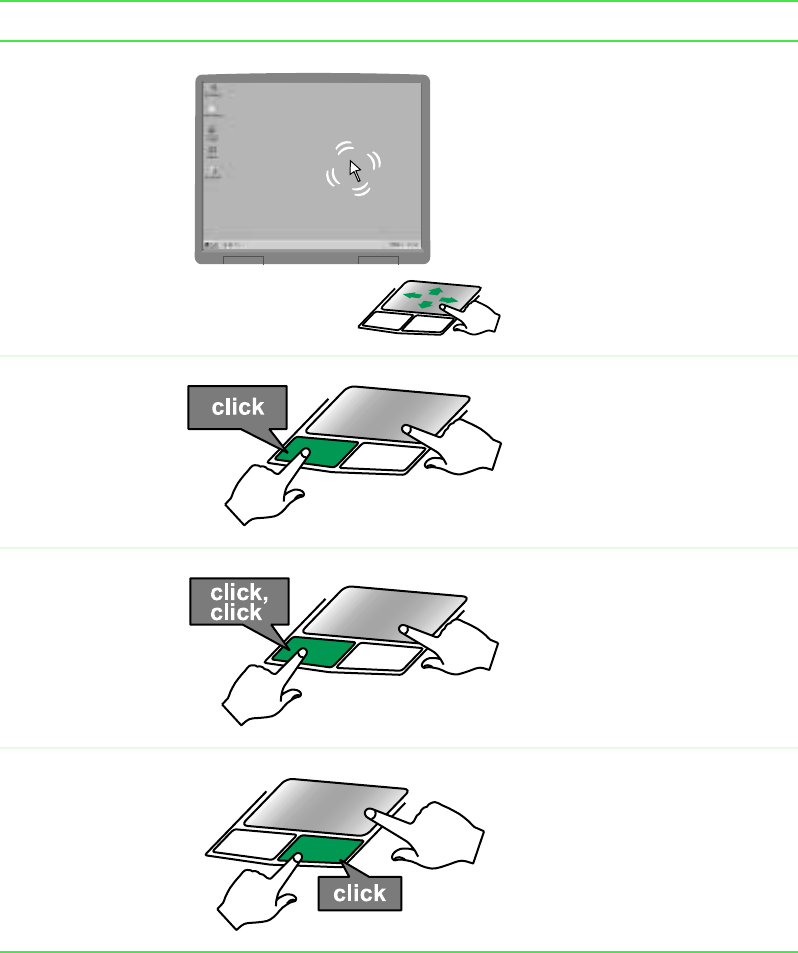
43
Using the EZ Pad touchpad
www.gateway.com
Using the touchpad
To... Do this...
Move the pointer
on the screen. Move your finger around on the
touchpad. If you run out of
space on your touchpad and
need to move the pointer
farther, lift your finger, move it
to the middle of the touchpad,
then continue moving your
finger.
Select an object
on the screen. Position the pointer over the
object. Press the left button
below the touchpad once. This
action is called clicking.
Start a program
or open a file or
folder.
Position the pointer over the
object. Press the left button
below the touchpad twice in
rapid succession. This action is
called double-clicking.
Access a
shortcut menu or
find more
information
about an object
on the screen.
Position the pointer over the
object. Quickly press and
release the right button once.
This action is called
right-clicking.
Solo9550.book Page 43 Tuesday, June 19, 2001 3:18 PM
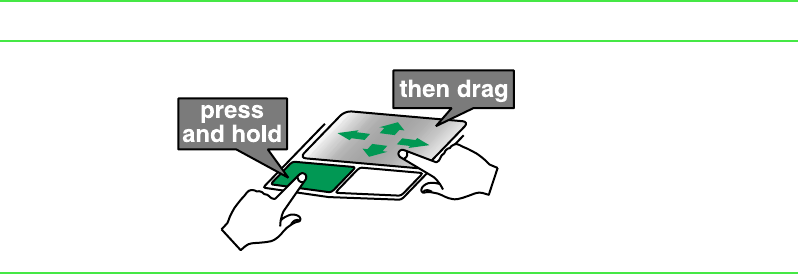
44
Chapter 3: Getting Started
www.gateway.com
Move an object
on the screen. Position the pointer over the
object. Press the left button
and hold it down, then use the
touchpad to move (drag) the
object to the appropriate part of
the screen. Release the button
to drop the object where you
want it.
To... Do this...
Solo9550.book Page 44 Tuesday, June 19, 2001 3:18 PM
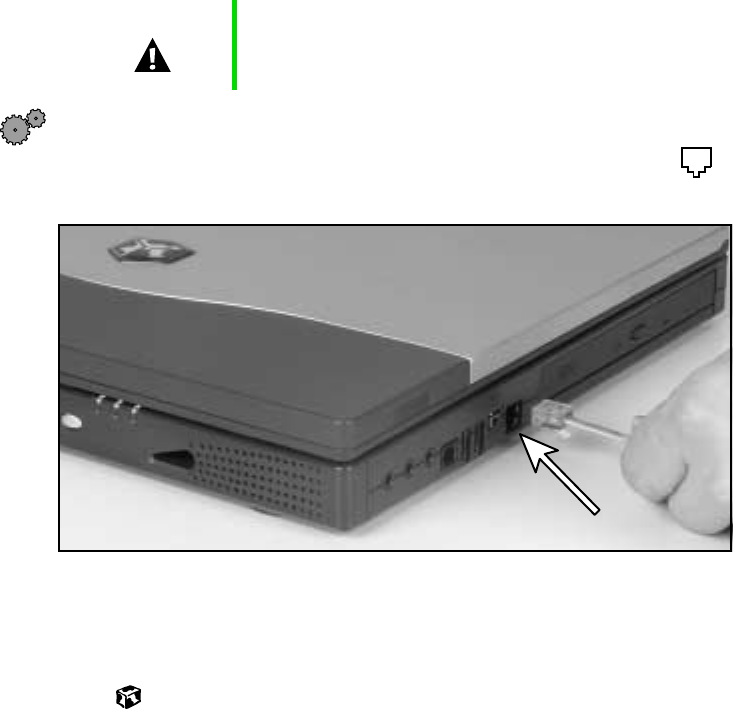
45
Connecting the modem
www.gateway.com
Connecting the modem
If your notebook has a modem jack, the notebook has a built-in 56K modem.
To connect the modem:
1Insert one end of the telephone cable into the modem jack on the
side of the notebook.
2Insert the other end of the telephone cable into a telephone wall jack.
The modem will not work with digital or PBX telephone lines.
3Start your notebook, then start your communications software.
Caution To reduce the risk of fire, use only No. 26 AWG or larger
telecommunications line cord.
Solo9550.book Page 45 Tuesday, June 19, 2001 3:18 PM
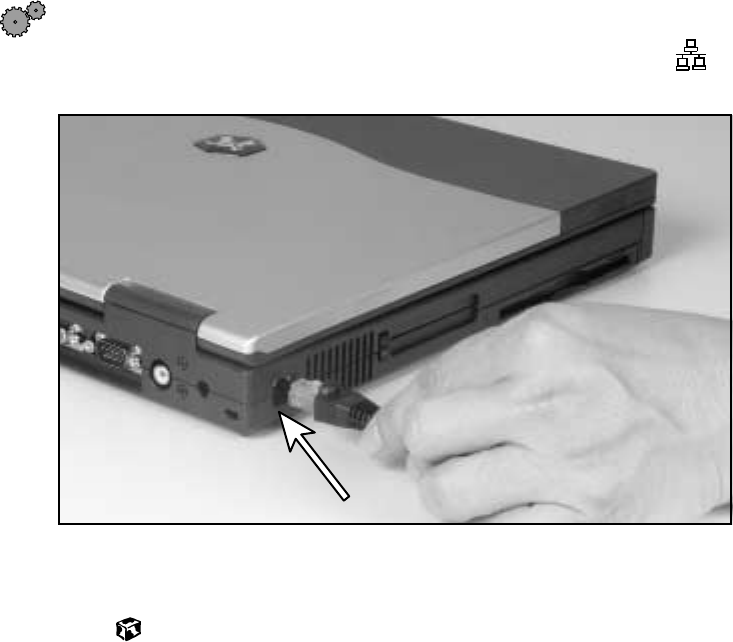
46
Chapter 3: Getting Started
www.gateway.com
Connecting to an Ethernet network
If your notebook has a network jack, you can connect it to a 10/100 Ethernet
network.
To connect to a network:
1Insert one end of the network cable into the network jack on the
left side of the notebook.
2Insert the other end of the network cable into a network wall jack. Ask
your network administrator to help you select the correct network jack.
Your notebook is now physically connected to the network. Your network
administrator can help you log onto your network.
Solo9550.book Page 46 Tuesday, June 19, 2001 3:18 PM
47
Connecting to an Ethernet network
www.gateway.com
Broadband Internet connections
You can use your computer’s Ethernet jack for more than just networking.
Many broadband Internet connections, such as cable modems and DSL
modems, connect to your computer’s Ethernet jack. For more information,
see “Using the Internet” on page 87 and “Networking Your Computer” on
page 199.
Solo9550.book Page 47 Tuesday, June 19, 2001 3:18 PM
48
Chapter 3: Getting Started
www.gateway.com
Installing a printer, scanner, or other
peripheral device
Your computer has one or more of the following ports: IEEE 1394 (Firewire),
Universal Serial Bus (USB), serial, and parallel. These ports are used for
connecting peripheral devices such as printers, scanners, and digital cameras
to your computer. For more information about port locations, see “Checking
Out Your Gateway Solo 9500” on page 1 and “Checking Out Your Gateway
Solo 9550” on page 11.
IEEE 1394 and USB ports support plug-and-play and hot swapping, which means
that your computer will usually recognize such a device whenever you plug
it into the appropriate port. When you use an IEEE 1394 or USB device for
the first time, your computer will prompt you to install any software the
device needs. After doing this, you can disconnect and reconnect the device
at any time.
Parallel and serial port devices are not plug-and-play. Refer to the device
documentation for detailed information and installation instructions.
Solo9550.book Page 48 Tuesday, June 19, 2001 3:18 PM